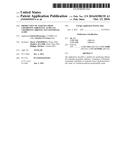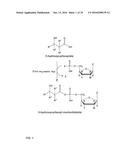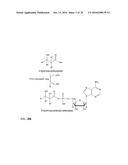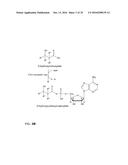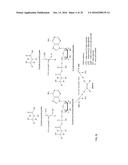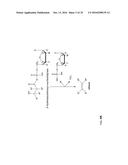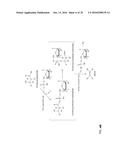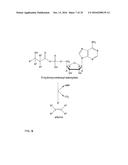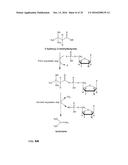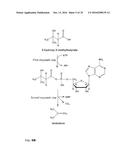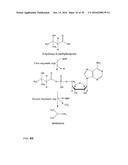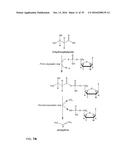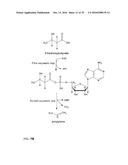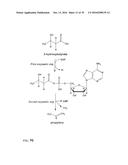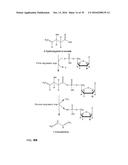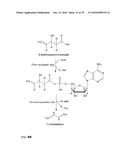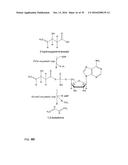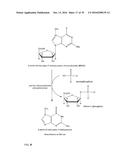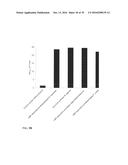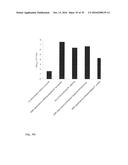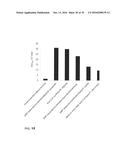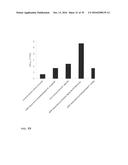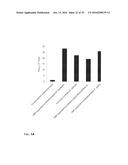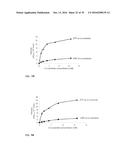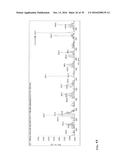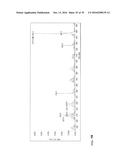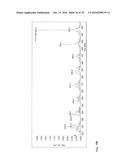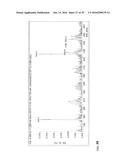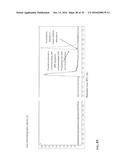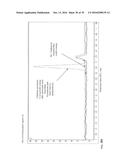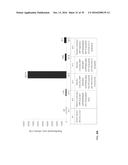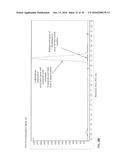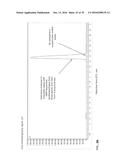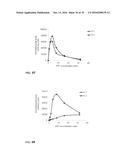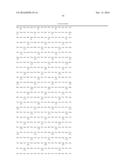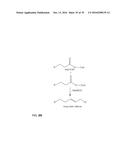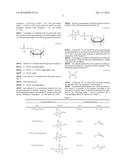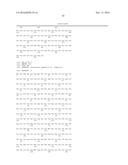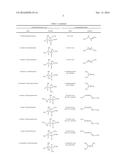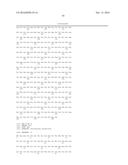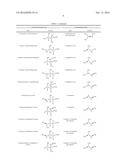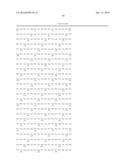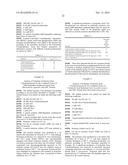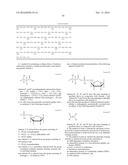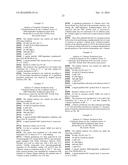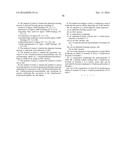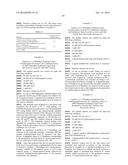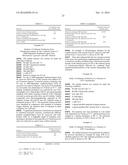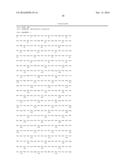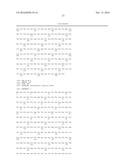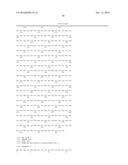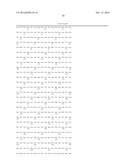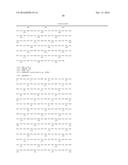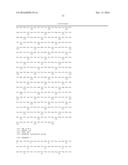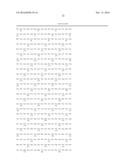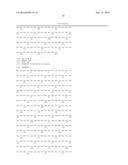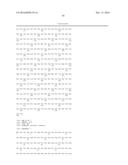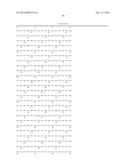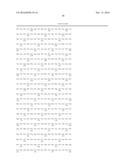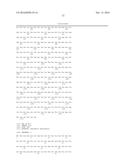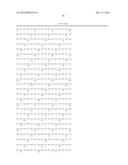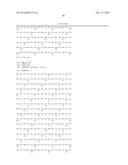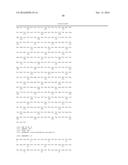Patent application title: PRODUCTION OF ALKENES FROM 3-HYDROXYCARBOXYLIC ACIDS VIA 3-HYDROXYCARBOXYL-NUCLEOTIDYLIC ACIDS
Inventors:
Maria Anissimova (Nozay, FR)
Mathieu Allard (Saint Vrain, FR)
Philippe Marliere (Tournai, BE)
Philippe Marliere (Tournai, BE)
IPC8 Class: AC12P502FI
USPC Class:
1 1
Class name:
Publication date: 2016-10-13
Patent application number: 20160298139
Abstract:
The application describes a method for producing alkenes (for example
propylene, ethylene, 1-butylene, isobutylene, isoamylene, butadiene or
isoprene) from 3-hydroxycarboxylic acids via
3-hydroxycarboxyl-nucleotidylic acids.Claims:
1. A method for producing an alkene from a 3-hydroxycarboxylate wherein a
3-hydroxycarboxylate of the following general formula I: ##STR00054##
wherein R.sup.1 and R.sup.3 are independently selected from hydrogen
(--H), methyl (--CH.sub.3), ethyl (--CH.sub.2--CH.sub.3), isopropyl
(--CH.sub.2(CH.sub.3).sub.2), vinyl (--CH.dbd.CH.sub.2) and isopropenyl
(--C(CH.sub.3).dbd.CH.sub.2) and in which R.sup.2 and R.sup.4 are
independently selected from hydrogen (--H) and methyl (--CH.sub.3), is,
in a first step, enzymatically converted together with a co-substrate of
the following formula II: ##STR00055## wherein X is selected from the
group consisting of O--PO.sub.3H.sub.2 monophosphate,
O--PO.sub.2H--O--PO.sub.3H.sub.2 diphosphate, and O--SO.sub.3H sulfate,
and wherein Y is selected from the group consisting of OH hydroxyl and
O--PO.sub.3H.sub.2 monophosphate, and wherein Z is a nucleobase selected
from the group consisting of adenine, guanine, thymine, cytosine, uracil
and hypoxanthine, and wherein W is selected from the group consisting of
hydrogen (--H) hydroxyl (OH), into a 3-hydroxycarboxyl-nucleotidylate of
the following general formula III: ##STR00056## wherein R.sup.1,
R.sup.2, R.sup.3 and R.sup.4 have the same meaning as specified above in
connection with formula I and wherein W, Y and Z have the same meaning as
specified above in connection with formula II, and in that the thus
produced 3-hydroxycarboxyl-nucleotidylate is subsequently enzymatically
converted into an alkene of the following general formula IV:
##STR00057## wherein R.sup.1, R.sup.2, R.sup.3 and R.sup.4 have the same
meaning as specified above in connection with formula I.
2. The method of claim 1 wherein the enzymatic conversion of the 3-hydroxycarboxylic acid into the 3-hydroxycarboxyl-nucleotidylate is achieved by the use of an adenylate forming enzyme.
3. The method of claim 2, wherein the adenylate forming enzyme is selected from the group consisting of: an AMP-dependent synthetase and ligase an adenylation domain of a non-ribosomal peptide synthetase (NRPS); an acyl- or aryl-CoA synthetases; a (luciferase) oxidoreductases; an adenylation domain of a polyketide synthase (PKS); an aminoacyl-tRA synthetase; and an NIS enzyme.
4. The method of claim 2, wherein the adenylate forming enzyme is selected from the group consisting of: acetate:CoA ligase (AMP forming) (EC 6.2.1.1); butanoate:CoA ligase (AMP forming) (EC 6.2.1.2); long-chain fatty acid:CoA ligase (AMP-forming) (EC 6.2.1.3); 4-Coumarate-CoA ligase (EC 6.2.1.12); long-chain-fatty-acid:[acyl-carrier protein] ligase (AMP-forming) (EC 6.2.1.20); 4-chlorobenzoate:CoA ligase (EC 6.2.1.33); and 3-hydroxypropionate:CoA ligase (AMP-forming) (EC 6.2.1.36).
5. The method of claim 2, wherein the adenylate forming enzyme is carboxylic acid reductases (CAR).
6. The method of claim 1, wherein the enzymatic conversion of the 3-hydroxycarboxyl-nucleotidylate into the corresponding alkene by a denucleotidylation/decarboxylation is achieved by using an OleC protein.
7. The method of claim 1, wherein the method is carried out in vitro.
8. The method of claim 1, wherein the method is carried out in the presence of a microorganism producing an enzyme catalyzing the conversion of the 3-hydroxycarboxylate into the 3-hydroxycarboxyl-nucleotidylate and producing an enzyme catalyzing the conversion of the 3-hydroxycarboxyl-nucleotidylate into the alkene.
9. The method according to claim 1, comprising a step of collecting the gaseous alkene degassing out of the reaction.
10. An organism or a microorganism which expresses (a) an adenylate-forming enzyme; and (b) an OleC protein.
11. A composition comprising (i) an adenylate-forming enzyme and a 3-hydroxycarboxylate of formula I; or (ii) (a) an OleC protein; and (b) a 3-hydroxycarboxyl-nucleotidylate of formula III; or (iii) (a) an adenylate-forming enzyme; and (b) an OleC protein.
12. Use of the organism or microorganism of claim 10 for producing an alkene of formula IV from a 3-hydroxycarboxylate of formula I.
13. A composition comprising the microorganism of claim 10, a suitable culture medium and a 3-hydroxycarboxylate of formula I or a carbon source that can be converted by the microorganism to 3-hydroxycarboxylate of formula I.
14. Use of the composition of claim 11 for producing an alkene of formula IV from a 3-hydroxycarboxylate of formula I.
Description:
[0001] The present invention relates to a method for generating alkenes
through a biological process. More specifically, the invention relates to
a method for producing alkenes (for example propylene, ethylene,
1-butylene, isobutylene, isoamylene, butadiene or isoprene) from
3-hydroxycarboxylic acids via 3-hydroxycarboxyl-nucleotidylic acids.
[0002] A large number of chemical compounds are currently derived from petrochemicals. Alkenes (such as ethylene, propylene, the different butenes, or else the pentenes, for example) are used in the plastics industry, for example for producing polypropylene or polyethylene, and in other areas of the chemical industry and that of fuels.
[0003] Ethylene, the simplest alkene, lies at the heart of industrial organic chemistry: it is the most widely produced organic compound in the world. It is used in particular to produce polyethylene, a major plastic. Ethylene can also be converted to many industrially useful products by reaction (of oxidation, of halogenation). Propylene holds a similarly important role: its polymerization results in a plastic material, polypropylene. The technical properties of this product in terms of resistance, density, solidity, deformability, and transparency are unequalled. The worldwide production of polypropylene has grown continuously since its invention in 1954.
[0004] Butylene exists in four forms, one of which, isobutylene, enters into the composition of methyl-tert-butyl-ether (MTBE), an anti-knock additive for automobile fuel. Isobutylene can also be used to produce isooctene, which in turn can be reduced to isooctane (2,2,4-trimethylpentane); the very high octane rating of isooctane makes it the best fuel for so-called "gasoline" engines.
[0005] Amylene, hexene and heptene exist in many forms according to the position and configuration of the double bond. These products have real industrial applications but are less important than ethylene, propylene or butenes.
[0006] All these alkenes are currently produced by catalytic cracking of petroleum products (or by a derivative of the Fisher-Tropsch process in the case of hexene, from coal or gas). Their cost is therefore naturally indexed to the price of oil. Moreover, catalytic cracking is sometimes associated with considerable technical difficulties which increase process complexity and production costs. In the alkene chemical family, isoprene (2-methyl-1,3-butadiene) is the terpene motif which, through polymerization, leads to rubber. Other terpenes might be developed, by chemical, biological or mixed pathways, as usable products such as biofuels or to manufacture plastics. WO2008/113041 proposes a biological process for producing hydrocarbons from renewal resources in which the microorganism converts a substrate containing a fatty acyl chain. The production of alkenes, in particular terminal alkenes (ethylene mono- or di-substituted at position 2: H.sub.2C.dbd.C(R.sup.1)(R.sup.2)) has apparently been less extensively investigated. The conversion of isovalerate to isobutylene by the yeast Rhodotorula minuta has been described (Fujii T. et al., Appl. Environ. Microbiol., 1988, 54:583), but the efficiency of this reaction, characterized by a very low value of the turnover number (k.sub.cat is 1.times.10.sup.-5 sec.sup.-1), is far from permitting an industrial application. Large-scale biosynthesis of isobutylene by this pathway seems highly unfavorable, since it would require the synthesis and degradation of one molecule of leucine to form one molecule of isobutylene. Also, the enzyme catalyzing the reaction uses heme as cofactor, poorly lending itself to recombinant expression in bacteria and to improvement of enzyme parameters. Other microorganisms have been described as being marginally capable of naturally producing isobutylene from isovalerate; the yields obtained are even lower than those obtained with Rhodotorula minuta (Fukuda H. et al, Agric. Biol. Chem., 1984, 48:1679).
[0007] The same studies have also described the natural production of propylene: many microorganisms are capable of producing propylene, once again with an extremely low yield. The production of ethylene by plants has long been known (Meigh et al, 1960, Nature, 186:902). According to the metabolic pathway elucidated, methionine is the precursor of ethylene (Adams and Yang, PNAS, 1979, 76:170). Conversion of 2-oxoglutarate has also been described (Ladygina N et al., Process Biochemistry 2006, 41:1001). Since the production of a two-carbon molecule of ethylene consumes a four- or five-carbon molecule precursor, these pathways appear materially and energetically unfavorable for their industrial application. WO2010/001078 describes a process for producing alkenes by enzymatic conversion of 3-hydroxyalkanoic acids with an enzyme having the activity of a decarboxylase. Such a method is advantageous because it helps to avoid the use of petroleum products, to lower the costs of producing plastics and fuels and can have a considerable global environmental impact by allowing carbon to be stored in solid form. Although the method described in WO 2010/001078 allows producing alkenes by enzymatic reactions, there is still a need for further methods allowing the production of alkenes in biological systems which can be extended to an industrial scale. The present application addresses this need.
[0008] The present invention relates to a method for producing an alkene characterized in that it comprises the conversion of a 3-hydroxycarboxylate through a biological process, in particular an enzymatic process, wherein a 3-hydroxycarboxylate is, in a first step, enzymatically converted into a 3-hydroxycarboxyl-nucleotidylate and wherein the thus produced 3-hydroxycarboxyl-nucleotidylate is subsequently converted into the alkene. The enzymatic conversion of the 3-hydroxycarboxylate in the first step into a 3-hydroxycarboxyl-nucleotidylate comprises a nucleotidylation reaction. The conversion of the produced 3-hydroxycarboxyl-nucleotidylate into the alkene comprises an elimination of carbon dioxide and denucleotidylation. When used in the present invention, the suffix "-ate/-oate" can interchangeable denote either the carboxylate ion (COO--) or carboxylic acid (COOH).
[0009] The term "3-hydroxycarboxylate", as used herein, denotes a molecule responding to the following general formula I:
##STR00001##
[0010] in which R.sup.1 and R.sup.3 are independently selected from hydrogen (--H), methyl (--CH.sub.3), ethyl (--CH.sub.2--CH.sub.3), isopropyl (--CH.sub.2(CH.sub.3).sub.2), vinyl (--CH.dbd.CH.sub.2) and isopropenyl (--C(CH.sub.3).dbd.CH.sub.2) and in which R.sup.2 and R.sup.4 are independently selected from hydrogen (--H) and methyl (--CH.sub.3).
[0011] According to a method of the invention the 3-hydroxycarboxylate is enzymatically converted together with a co-substrate responding to the following general formula II:
##STR00002##
[0012] wherein X is selected from the group consisting of
[0013] O--PO.sub.3H.sub.2 monophosphate,
[0014] O--PO.sub.2H--O--PO.sub.3H.sub.2 diphosphate, and
[0015] O--SO.sub.3H sulfate,
[0016] and wherein Y is selected from the group consisting of
[0017] OH hydroxyl and
[0018] O--PO.sub.3H.sub.2 monophosphate,
[0019] and wherein Z is a nucleobase selected from the group consisting of adenine, guanine, thymine, cytosine, uracil and hypoxanthine, and wherein W is selected from the group consisting of hydrogen (--H) and hydroxyl (OH)
[0020] into the corresponding 3-hydroxycarboxyl-nucleotidylate of the following general formula III:
##STR00003##
[0021] in which R.sup.1, R.sup.2, R.sup.3 and R.sup.4 have the same meaning as specified above in connection with formula I and wherein W, Y and Z have the same meaning as specified above in connection with formula II.
[0022] According to a method of the present invention the thus produced 3-hydroxycarboxyl-nucleotidylate is further converted into an alkene.
[0023] The alkene produced by the method according to the present invention is a molecule which responds to the following general formula IV:
##STR00004##
[0024] in which R.sup.1, R.sup.2, R.sup.3 and R.sup.4 have the same meaning as specified above in connection with formula I.
[0025] In preferred embodiments the 3-hydroxycarboxylate which is converted in the method according to the invention is selected from a 3-hydroxycarboxylate as specified in the following Table 1 and is converted into a corresponding alkene as indicated in Table 1.
TABLE-US-00001 TABLE 1 3-hydroxycarboxylic acid Corresponding alkene name formula name formula 3-hydroxypropionate ##STR00005## ethylene H.sub.2C.dbd.CH.sub.2 3-hydroxybutyrate ##STR00006## propylene ##STR00007## 2-methyl-3-hydroxypropionate ##STR00008## propylene ##STR00009## 3-hydroxypentanoate ##STR00010## but-1-ene ##STR00011## 2-(hydroxymethyl)butyrate ##STR00012## but-1-ene ##STR00013## 2-methyl-3-hydroxybutyrate ##STR00014## (Z) but-2-ene ##STR00015## 2-methyl-3-hydroxybutyrate ##STR00016## (E) but-2-ene ##STR00017## 3-hydroxy-3-methylbutyrate ##STR00018## 2-methylpropylene aka isobutene ##STR00019## 2,2-dimethyl-3-hydroxypropionate ##STR00020## 2-methylpropylene aka isobutene ##STR00021## 2-methyl-3-hydroxypentanoate ##STR00022## (Z) pent-2-ene aka (Z) 2-amylene ##STR00023## 2-ethyl-3-hydroxybutyrate ##STR00024## (Z) pent-2-ene aka (Z) 2-amylene ##STR00025## 2-methyl-3-hydroxypentanoate ##STR00026## (E) pent-2-ene aka (E) 2-amylene ##STR00027## 2-ethyl-3-hydroxybutyrate ##STR00028## (E) pent-2-ene aka (E) 2-amylene ##STR00029## 2,3-dimethyl-3-hydroxybutyrate ##STR00030## 2-methylbut-2-ene aka isoamylene ##STR00031## 2,2-dimethyl-3-hydroxybutyrate ##STR00032## 2-methylbut-2-ene aka isoamylene ##STR00033## 3-methyl-3-hydroxypentanoate ##STR00034## 2-methylbut-1-ene ##STR00035## 2-methyl-2-(hydroxymethyl)butyrate ##STR00036## 2-methylbut-1-ene ##STR00037## 4-methyl-3-hydroxypentanoate ##STR00038## 3-methylbut-1-ene ##STR00039## 2-(hydroxymethyl)-3-methylbutyrate ##STR00040## 3-methylbut-1-ene ##STR00041## 3-hydroxypent-4-enoate ##STR00042## 1,3-butadiene ##STR00043## 2-(hydroxymethyl)but-3-enoate ##STR00044## 1,3-butadiene ##STR00045## 3-hydroxy-4-methylpent-4-enoate ##STR00046## 2-methyl-1,3-butadiene aka isoprene ##STR00047## 3-hydroxy-3-methylpent-4-enoate ##STR00048## 2-methyl-1,3-butadiene aka isoprene ##STR00049## 2-(hydroxymethyl)-2-methylbut-3- enoate ##STR00050## 2-methyl-1,3-butadiene aka isoprene ##STR00051## 2-(hydroxymethyl)-3-methylbut-3- enoate ##STR00052## 2-methyl-1,3-butadiene aka isoprene ##STR00053##
[0026] As described above, according to the method of the invention a 3-hydroxycarboxylate is first converted into a 3-hydroxycarboxyl-nucleotidylate. This is achieved by a nucleotidylation reaction, i.e. a reaction in which a nucleotidyl group is transferred from the co-substrate (Formula II) to the carboxyl group of the 3-hydroxycarboxylate. The general reaction is shown in FIG. 1.
[0027] Examples for the co-substrate according to formula II are ribonucleotides, such as ATP, CTP, GTP, UTP and ITP, with ATP being preferred, and ADP, CDP, GCP UDP and IDP, with ADP being preferred. Other examples are desoxyribonucleotides, such as dATP, dCTP, dGTP, dTTP and dITP. Further examples are 3'-phosphoadenosin-5'-phosphosulfate (PAPS) or adenosin-5'-phosphosulfate (APS).
[0028] In a preferred embodiment, Z is adenine. In another preferred embodiment, Z is adenine and W is H. In a further preferred embodiment, Z is adenine, W is H and X is monophosphate or diphosphate. In another preferred embodiment, Z is adenine, W is H, X is sulfate and Y is OH or monophosphate. In another particularly preferred embodiment Z is adenine, W and Y are OH. In another preferred embodiment Z is adenine, W is H and Y is OH. In a further preferred embodiment Z is adenine, W and Y are OH and X is monophosphate or diphosphate. In another preferred embodiment, Z is adenine, W is OH, X is sulfate, Y is OH or monophosphate.
[0029] In a preferred embodiment, the conversion of the 3-hydroxycarboxylate in the first step of the method according to the invention leads to a 3-hydroxycarbonyl-adenylate.
[0030] In one preferred embodiment, the co-substrate of the formula II is ATP or ADP and the first enzymatic conversion is an adenylation. The reaction is schematically shown in FIG. 2. The scheme for the overall reaction leading to the alkene is shown in FIG. 3.
[0031] The conversion of the 3-hydroxycarboxylate into the 3-hydroxycarboxyl-nucleotidylate according to the method of the present invention can preferably be achieved by an enzymatic reaction, in particular by the use of an enzyme which catalyzes the transfer of a nucleotidyl group onto a molecule.
[0032] In one embodiment of the method according to the invention enzymes which are classified as an "adenylate forming enzyme" are used for the conversion of the 3-hydroxycarboxylate into a 3-hydroxycarboxyl-nucleotidylate. The term "adenylate forming enzyme" is understood to mean an enzyme which is capable of catalysing the following reaction:
substrate+ATP.fwdarw.substrate-adenylate+diphosphate
[0033] (see, e.g., Schmelz and Naismith (Curr. Opin. Struc. Biol. 19 (2009), 666-671; Linne et al., FEBS Letters 581 (2007), 905-910). Although ATP is indicated as the co-substrate, it is known that adenylate-forming enzymes can use other co-substrates such as ADP, UTP, CTP, GTP and ITP. Thus, in the scope of the present invention the term "adenylate-forming" is not limiting in the sense that the enzymes only produce an adenylated product, but is only used as the established term used in the art but also covers the possibility that the respective enzymes can use other co-substrates as defined in Formula II. Preferably the group on the substrate to which the nucleotidyl moiety is transferred is a carboxylic group. As described in Schmelz and Naismith (loc. cit.) adenylating enzymes activate the otherwise unreactive carboxylic acid by transforming the normal hydroxyl leaving group into adenosine monophosphate. These enzymes share the following common structural features referenced in different databases:
[0034] 1. InterPro database (InterPro44.0; Release Sep. 25, 2013)
[0035] IPR020845, AMP-binding, conserved site (http://www.ebi.ac.uk/interpro/entry/IPR020845)
[0036] IPR000873 (http://www.ebi.ac.uk/interpro/entry/IPR000873)
[0037] 2. Prosite
[0038] PS00455 (http://prosite.expasy.org/PS00455)
[0039] Description: Putative AMP-binding domain signature.
[0040] Pattern: [LIVMFY]-{E}-{VES}-[STG]-[STAG]-G-[ST]-[STEI]-[SG]-x-[PASLIVM]-[KR].
[0041] (Entry name AMP_BINDING; Accession number PS00455; Entry type PATTERN; Date May 1991 (CREATED); December 2004 (DATA UPDATE); October 2013 (INFO UPDATE). Pattern [LIVMFY]-{E}-{VES}-[STG]-[STAG]-G-[ST]-[STEI]-[SG]-x-[PASLIVM]-[KR])
[0042] 3. Pfam
[0043] The accession number for these enzymes in the Pfam database is PF00501.
[0044] Adenylate forming enzymes are, e.g., described in Schmelz and Naismith (Curr. Opin. Struc. Biol. 19 (2009), 666-671). Based on sequence analysis a superfamily of adenylate forming enzymes has been identified which can be subdivided into three closely related sub-families.
[0045] The first sub-family (referred to as Class I) comprises the following sub-classes:
[0046] the adenylation domains of non-ribosomal peptide synthetases (NRPS);
[0047] the acyl- or aryl-CoA synthetases;
[0048] the (luciferase) oxidoreductases; and
[0049] the adenylation domain of polyketide synthase (PKS).
[0050] Also the AMP-dependent synthetases and ligases described herein further below can be classified into this class.
[0051] The second sub-family (referred to as Class II) comprises:
[0052] the aminoacyl-tRNA synthetases.
[0053] The third sub-family (referred to as Class III) comprises:
[0054] the NIS enzymes.
[0055] NIS enzymes are enzymes involved in the NRPS-independent siderophores (NIS) synthesis.
[0056] In a preferred embodiment the method according to the present invention employs an enzyme which belongs to the above, mentioned Class I.
[0057] In one embodiment the enzyme belongs to Class I and to the subclass comprising the adenylation domains of non-ribosomal peptide synthetases (NRPS) (Marahiel, Chem. Rev. 97 (1997), 2651-2673; Sundlov et al., Chem Biol. 19 (2012), 188-198; Sundlov et al., Acta Cryst. D69 (2013). 1482-1492; May et al., PNAS 99 (2002), 12120-12125; Keating, Biochemistry 39 (2000), 4729-4739).
[0058] In another embodiment the enzyme belongs to Class I and to the subclass comprising the acyl- or aryl-CoA synthetases (Soupene and Kuypers, Exp Biol Med 233 (2008), 507-521; Mashek et al., Future Lipidol. 2 (2007), 465-476; Ehlting et al., The Plant Journal 27(2001), 455-465).
[0059] In another embodiment the enzyme belongs to Class I and to the subclass comprising the (luciferase) oxidoreductases. One representative example of such an enzyme and a preferred enzyme to be used in a method according to the present invention is the firefly luciferase (Oba et al., FEBS Letters 540 (2003), 251-254).
[0060] In another embodiment the enzyme belongs to Class I of adenylate forming enzymes and to the subclass comprising the adenylation domain of a polyketide synthase (PKS). A representative example of this group of enzymes is the polyketide-peptide synthase of Xanthomonas albilineans (Huang et al., Microbiology 147 (2001), 631-642).
[0061] Enzymes which belong to the above mentioned Class I of adenylate forming enzymes are classified in the EC 6.2.1 superfamily. In principle any enzyme classified as EC 6.2.1 can be employed in a method according to the present invention. Examples for such adenylate forming enzymes are:
[0062] EC 6.2.1.1 acetate:CoA ligase (AMP forming);
[0063] EC 6.2.1.2 butanoate:CoA ligase (AMP forming);
[0064] EC 6.2.1.3 long-chain fatty acid:CoA ligase (AMP-forming);
[0065] EC 6.2.1.12 4-Coumarate-CoA ligase;
[0066] EC 6.2.1.20 long-chain-fatty-acid:[acyl-carrier protein] ligase (AMP-forming);
[0067] EC 6.2.1.33 4-chlorobenzoate:CoA ligase; and
[0068] EC 6.2.1.36 3-hydroxypropionate:CoA ligase (AMP-forming).
[0069] All the enzymes of this group share common structural motifs which are referenced in the InterPro (InterPro44.0; Release Sep. 25, 2013) as InterPro IPR020845, AMP-binding, conserved site (http://www.ebi.ac.uk/interpro/entry/IPR020845) and IPR000873 (http://www.ebi.ac.uk/interpro/entry/IPR000873). The accession number for these enzymes in the Pfam database is PF00501.
[0070] Thus, in one preferred embodiment the enzymatic conversion of the 3-hydroxycarboxylate into a corresponding 3-hydroxycarboxyl-nucleotidylate can, e.g., be achieved by the use of an acetate:CoA ligase (AMP forming) (EC 6.2.1.1). Acetate:CoA ligases are enzymes which catalyze the following reaction:
ATP+acetate+CoA.fwdarw.AMP+diphosphate+acetyl-CoA
[0071] The reaction is a two-step reaction which involves the formation of an acetyl-AMP intermediate from acetate and ATP and the transfer of the acetyl group to CoA. These enzymes are present in most living organisms from bacteria to humans.
[0072] The occurrence of these enzymes has been described for a large number of organisms, including prokaryotes and eukaryotes, in particular, bacteria, algae, fungi, plants and animals, e.g. for S. cerevisiae, Moorella thermoacetica, Pyrococcus furiosus, Archaeoglobus fulgidus, Methanothermobacter thermoautotropicus, Methanosaeta concilii, Methanosarcina sp., Bacillus subtilis, Salmonella enteric, Aliivibrio fischeri, E. coli, Holoarcula marismortui, Bradyrhizobium japonicum, Oryctolagus cuniculus, Ovis aries, Penicillium chrysogenum, Phycomyces blakesleeanus, Cryptosporidium parvum, Emericella nidulans, Euglena gracilis, Pseudomonas aeruginosa, Pseudomonas putida, Pyrobaculum aerophilum, Rhodobacter sphaeroides, Roseovarius sp., Neurospora crassa, Pinus radiate, Spinacia oleracea, Taxus sp., Zea mays, Arabidopsis thaliana, Pisum sativum, Amaranthus sp., Hordeum vulgare, Rattus norvegicus, Mus musculus, Mormota monax, Bos taurus and Homo sapiens. For the enzyme from S. cerevisiae the crystal structure has been disclosed e.g. in Jogl and Tong (Biochemistry 43 (2004), 1425-1431). In principle, any known acetate:CoA ligase can be employed in the method according to the invention. In one aspect of the present invention, an acetate:CoA ligase from S. cerevisiae is used (Jogl and Tong; loc. cit.).
[0073] In another preferred embodiment the enzymatic conversion of the 3-hydroxycarboxylate into a corresponding 3-hydroxycarboxyl-nucleotidylate can, e.g., be achieved by the use of a butanoate:CoA ligase (AMP forming) (EC 6.2.1.2). Butanoate:CoA ligases are enzymes which catalyze the following reaction:
ATP+a carboxylate+CoA.fwdarw.AMP+diphosphate+an acyl-CoA
[0074] These enzymes participate in butanoate metabolism. The occurrence of these enzymes has been described for a large number of organisms, including prokaryotes and eukaryotes, in particular, bacteria, algae, fungi, plants and animals, e.g. for Streptomyces coelicolor, Mycobacterium avium, Penicillium chrysogenum, Paecilomyces variotii, Pseudomonas aeruginosa, Dictyostelium discoideum, Cavia porcellus, Ovis aries, Sus scrofa, Bos taurus, Mus musculus, Rattus norvegicus, and Homo sapiens.
[0075] In another preferred embodiment the enzymatic conversion of the 3-hydroxycarboxylate into a corresponding 3-hydroxycarboxyl-nucleotidylate can, e.g., be achieved by the use of a long-chain fatty acid:CoA ligase (AMP-forming) (EC 6.2.1.3) (also known as fatty acyl-CoA synthetases; FACS). These enzymes catalyze the following reaction:
ATP+a long-chain fatty acid+CoA.fwdarw.AMP+diphosphate+an acyl-CoA
[0076] One of the key features of this catalysis is the formation of an adenylated intermediate, i.e. fatty acyl-AMP. This activation step involves the linking of the carboxyl group of the fatty acid through an acyl bond to the phosphoryl group of AMP.
[0077] These enzymes play a central role in the intermediary metabolism by catalyzing the formation of fatty acyl-CoA. Accordingly, they occur basically in all organisms and have been described, e.g., for S. cerevisiae, E. coli, Pseudomonas aeruginosa, Pseudomonas chlororaphis, Caulobacter vibrioides, Mycobacterium tuberculosis, Trypanosoma brucei, Emericella nidulans, Yarrowia lipolytica, Plasmodium falciparum, Plasmodium knowlesi, Ceanorhabditis elegans, Drosophila melanogaster, Mortierella alpina, Thalassiosira pseudonana, Photinus pyralis, Tribolium castaneum, Oryctolagus cuniculus, Komagataella pastoris, Luciola cruciata, Notothenia coriiceps, Pisum sativum, Zea mays, Arabidopsis thaliana, Ulmus sp., Brassica napus, Agrypnus binodulus, Bebesia bovis, Mus musculus, Rattus norvegicus, Sus scrofa and Homo sapiens. In principle, any known long-chain fatty acid:CoA ligase can be employed in the method according to the invention. In one aspect of the present invention, a long-chain fatty acid:CoA ligase from E. coli is used. The enzyme in E. coli is encoded by the fadD gene (Weimar et al., J. Biol. Chem. 277 (2002), 29369-29376).
[0078] In another preferred embodiment the enzymatic conversion of the 3-hydroxycarboxylate into a corresponding 3-hydroxycarboxyl-nucleotidylate can, e.g., be achieved by the use of a 4-coumarate-CoA ligase (EC 6.2.1.12). 4-coumarate-CoA ligases are enzymes which catalyze the following reaction:
ATP+4-coumarate+CoA.fwdarw.AMP+diphosphate+4-coumaroyl-CoA
[0079] 4-coumarate-CoA ligases catalyze the formation of CoA thiol esters of 4-coumarate and other hydroxycinnamates in a two step reaction involving the formation of an adenylate intermediate. These enzymes are involved in phenylpropanoid biosynthesis. The occurrence of these enzymes has been described for a large number of organisms, in particular eukaryotes, and in particular fungi and plants, e.g. for S. cerevisiae, Fragaria.times.ananassa, Oryza sativa, Lithospermum erythrorhizon, Eriobotrya japonica, Arabidopsis thaliana Physcomitrella patens, Ruta graveolens, Robinis pseudoacacia, Nicotiana tabacum, Vitis vinifera, Larix cajanderi, Larix gmelinii, Larix kaempferi, Larix kamtschatica, Larix sibirica, Larix, sukaczewii, Cocos nucifera, Pinus radiate, Camellia sinensis, Centaureum erythraea, Cephalocereus senilis, Forsythia suspensa, Glycine max, Gossypium hirsutum, Lolium perenne, Nicotiana tabacum, Metasequoia glyptostroboides, Paulownia tomentosa, Petroselinum crispum, Phyllostacchus bambusoides, Picea abies, Pinus taesa, Pisum sativum, Platycladus orientalis, Polysporus hispidus, Populus tomentosa, Populus tremuloides, Populus trichocarpa, Populus Canadensis, Prunus avium, Solanum tuberosum, Salix babylonica, Triticum and aestivum. In principle, any known 4-coumarate-CoA ligase can be employed in the method according to the invention. In one embodiment the 4-coumarate-CoA ligase from A. thaliana is employed (Ehlting et al., Plant J. 27 (2001), 455-465).
[0080] In another preferred embodiment the enzymatic conversion of the 3-hydroxycarboxylate into a corresponding 3-hydroxycarboxyl-nucleotidylate can, e.g., be achieved by the use of a long-chain fatty acid:[acyl-carrier protein] ligase (AMP-forming) (EC 6.2.1.20). These enzymes catalyze the following reaction:
ATP+an acid+[acyl-carrier protein].fwdarw.AMP+diphosphate+acyl-[acyl-carrier protein]
[0081] One of the key features of this catalysis is the formation of an adenylated intermediate, i.e. acyl-AMP. This activation step involves the linking of the carboxyl group of the acid through an acyl bond to the phosphoryl group of AMP.
[0082] These enzymes are involved in the fatty acid metabolism and they occur in various organisms. They have been described, e.g., for Vibrio harveyi, Plasmodium falciparum, E. coli, Synechococcus elongates, Synechococcus sp., Rhodotorula glutinis, Arabidopsis thaliana and Allium ampeloprasum. In Vibrio harveyi the enzyme is encoded by the aasS gene (Jiang et al., Biochemistry 45 (2006), 10008-10019). In principle, any known long-chain fatty acid:[acyl-carrier protein] ligase can be employed in the method according to the invention. In one embodiment the long-chain fatty acid:[acyl-carrier protein] ligase from Vibrio harveyi is employed.
[0083] In another preferred embodiment the enzymatic conversion of the 3-hydroxycarboxylate into a corresponding 3-hydroxycarboxyl-nucleotidylate can, e.g., be achieved by the use of a 4-chlorobenzoate:CoA ligase (AMP forming) (EC 6.2.1.33). 4-chlorobenzoate:CoA ligases are enzymes which catalyze the following reaction:
ATP+4-chlorobenzoate+CoA.fwdarw.AMP+diphosphate+4-chlorobenzoyl-CoA
[0084] These enzymes participate in the degradation of 2,4-dichlorobenzoate. They catalyze 4-chlorobenzoyl-CoA formation in a two-step reaction consisting of the adenylation of 4-chlorobenzoate with ATP followed by acyl transfer from the 4-chlorobenzoyl-AMP intermediate to CoA. The occurrence of these enzymes has been described e.g. for bacteria of the geni Alcaligenes, Pseudomonas and Arthrobacter. The enzyme from Pseudomonas sp. strain CBS3 is, e.g., described in Chang et al. (Biochemistry 36 (1997), 15650-15659).
[0085] In another preferred embodiment the enzymatic conversion of the 3-hydroxycarboxylate into a corresponding 3-hydroxycarboxyl-nucleotidylate can, e.g., be achieved by the use of a 3-hydroxypropionate:CoA ligase (AMP forming) (EC 6.2.1.36). 3-hydroxypropionate:CoA ligases are enzymes which catalyze the following reaction:
ATP+3-hydroxypropionate+CoA.fwdarw.AMP+diphosphate+3-hydroxypropionyl-Co- A
[0086] These enzymes catalyze a step in the 3-hydroxypropionate/4-hydroxybutyrate cycle. The occurrence of these enzymes has been described, e.g., for bacteria, in particular for Sulfolobus tokodaii and Metallosphaera sedula (Alber et al., J. Bacteriol. 190 (2008), 1383-1389). The enzyme from Pseudomonas sp. strain CBS3 is, e.g., described in Chang et al. (Biochemistry 36 (1997), 15650-15659). It is described in Chang et al. that the enzyme also activates propionate, acrylate, acetate and butyrate.
[0087] In a further preferred embodiment the enzymatic conversion of the 3-hydroxycarboxylate into a corresponding 3-hydroxycarboxyl-nucleotidylate can, e.g., be achieved by the use of the acyl-CoA synthetase from Marinobacter algicola showing the amino acid sequence shown in SEQ ID NO: 2 (see also Uniprot accession number A6EZ54). It is of course not only possible to use an enzyme having the amino acid sequence as shown in SEQ ID NO:2 but also enzymes with related sequences which show the activity of an acyl-CoA synthetase. Thus, in one preferred embodiment the method according to the present invention makes use of an acyl-CoA synthetase comprising the amino acid sequence shown in SEQ ID NO: 2 or a sequence which is at least x % identical to SEQ ID NO: 2 and which shows the activity of an acyl-CoA synthetase and can convert a 3-hydroxycarboxylate into a 3-hydroxycarboxyl-nucleotidylate as described herein-above, with x being an integer between 25 and 100, preferably 30, 35, 40, 45, 50, 55, 60, 65, 70, 75, 80, 85, 90, 91, 92, 93, 94, 95, 96, 97, 98 or 99.
[0088] The appended Examples demonstrate that this enzyme is capable of converting, e.g., 3-hydroxypropionate and ATP, 3-hydroxyvalerate and ATP, 3-hydroxypent-4-enoate and ATP, 3-hydroxyisovalerate and ATP and 3-hydroxybutyrate and ATP into the corresponding 3-hydroxycarboxyl-nucleotidylates. It is also shown in the Examples that this enzyme can use ATP or ADP as a co-substrate.
[0089] In another preferred embodiment the enzymatic conversion of the 3-hydroxycarboxylate into a corresponding 3-hydroxycarboxyl-nucleotidylate can, e.g., be achieved by the use of the acyl-CoA synthetase from Marinobacter manganoxidans showing the amino acid sequence shown in SEQ ID NO: 3 (see also Uniprot accession number G6YPQ6). It is of course not only possible to use an enzyme having the amino acid sequence as shown in SEQ ID NO:3 but also enzymes with related sequences which show the activity of an acyl-CoA synthetase. Thus, in one preferred embodiment the method according to the present invention makes use of an acyl-CoA synthetase comprising the amino acid sequence shown in SEQ ID NO: 3 or a sequence which is at least x % identical to SEQ ID NO: 3 and which shows the activity of an acyl-CoA synthetase and can convert a 3-hydroxycarboxylate into 3-hydroxycarboxyl-nucleotidylate as described herein-above, with x being an integer between 25 and 100, preferably 30, 35, 40, 45, 50, 55, 60, 65, 70, 75, 80, 85, 90, 91, 92, 93, 94, 95, 96, 97, 98 or 99.
[0090] In a further preferred embodiment the enzymatic conversion of the 3-hydroxycarboxylate into a corresponding 3-hydroxycarboxyl-nucleotidylate can, e.g., be achieved by the use of an AMP-dependent synthetase and ligase. AMP-dependent synthetase and ligases share the common structural motifs which are referenced in the InterPro (InterPro44.0; Release Sep. 25, 2013) as InterPro IPR020845, AMP-binding, conserved site (http://www.ebi.ac.uk/interpro/entry/IPR020845) and IPR000873 (http://www.ebi.ac.uk/interpro/entry/IPR000873). In principle any AMP-dependent synthetase and ligase can be employed in a method according to the present invention.
[0091] In one preferred embodiment the AMP-dependent synthetase and ligase is an AMP-dependent synthetase and ligase of Marinobacter aquaeolei showing the amino acid sequence shown in SEQ ID NO:1 (see also Uniprot accession number A1U2F4). It is of course not only possible to use an enzyme having the amino acid sequence as shown in SEQ ID NO:1 but also enzymes with related sequences which show the activity of an AMP-dependent synthetase and ligase. Thus, in one preferred embodiment the method according to the present invention makes use of an AMP-dependent synthetase and ligase comprising the amino acid sequence shown in SEQ ID NO: 1 or a sequence which is at least x % identical to SEQ ID NO: 1 and which shows the activity of an AMP-dependent synthetase and ligase and can convert a 3-hydroxycarboxylate into 3-hydroxycarboxyl-nucleotidylate as described herein-above, with x being an integer between 25 and 100, preferably 30, 35, 40, 45, 50, 55, 60, 65, 70, 75, 80, 85, 90, 91, 92, 93, 94, 95, 96, 97, 98 or 99.
[0092] The appended Examples demonstrate that this enzyme is capable of converting, e.g., 3-hydroxypropionate and ATP, 3-hydroxyvalerate and ATP, 3-hydroxypent-4-enoate and ATP, 3-hydroxyisovalerate and ATP and 3-hydroxybutyrate and ATP into the corresponding 3-hydroxycarboxyl-nucleotidylates. It is also shown that the corresponding 3-hydroxycarboxyl-nucleotidylate can be further converted into the corresponding alkene when the enzyme is used in combination with an OleC protein as described further below, preferably the OleC protein from Shewanella amazonensis, from Xanthomonas campestris or from Chloroflexus aurantiacus. This is, e.g., shown for the production of propylene from 3-hydroxybutyrate or for the production of 1-butene from 3-hydroxyvalerate or for the production of 1,3-butadiene from 3-hydroxypent-4-enoate or for the production of isobutene from 3-hydroxyisovalerate. Thus, in a preferred embodiment the method according to the present invention makes use of an AMP-dependent synthetase and ligase of Marinobacter aquaeolei as described herein-above and an OleC protein from Shewanella amazonensis, from Xanthomonas campestris, from Stenotrophomonas maltophilia or from Chloroflexus aurantiacus as described herein-below. More preferably, such a method is for producing propylene from 3-hydroxybutyrate or for producing 1-butene from 3-hydroxyvalerate or for producing 1,3-butadiene from 3-hydroxypent-4-enoate or for the production of isobutene from 3-hydroxyisovalerate.
[0093] In a further preferred embodiment the enzymatic conversion of the 3-hydroxycarboxylate into a corresponding 3-hydroxycarboxyl-nucleotidylate can, e.g., be achieved by the use of an AMP-dependent synthetase and ligase such as the AMP-dependent synthetase and ligase of Burkholderia sp. showing the amino acid sequence shown in SEQ ID NO: 4 (see also Uniprot accession number R4WRJ4). It is of course not only possible to use an enzyme having the amino acid sequence as shown in SEQ ID NO:4 or but also enzymes with related sequences which show the activity of an AMP-dependent synthetase and ligase. Thus, in one preferred embodiment the method according to the present invention makes use of an AMP-dependent synthetase and ligase comprising the amino acid sequence shown in SEQ ID NO: 4 or a sequence which is at least x % identical to SEQ ID NO: 4 and which shows the activity of an AMP-dependent synthetase and ligase and can convert a 3-hydroxycarboxylate into 3-hydroxycarboxyl-nucleotidylate as described herein-above, with x being an integer between 25 and 100, preferably 30, 35, 40, 45, 50, 55, 60, 65, 70, 75, 80, 85, 90, 91, 92, 93, 94, 95, 96, 97, 98 or 99.
[0094] The appended Examples demonstrate that this enzyme is capable of converting, e.g., 3-hydroxypropionate and ATP, 3-hydroxyvalerate and ATP, 3-hydroxypent-4-enoate and ATP, 3-hydroxyisovalerate and ATP and 3-hydroxybutyrate and ATP into the corresponding 3-hydroxycarboxyl-nucleotidylates. It is also shown in the Examples that this enzyme can use ATP or ADP as a co-substrate. It is furthermore shown that the corresponding 3-hydroxycarboxyl-nucleotidylate can be further converted into the corresponding alkene when the enzyme is used in combination with an OleC protein as described further below, preferably the OleC protein from Shewanella amazonensis or from Shewanella loihica. This is, e.g., shown for the production of propylene from 3-hydroxybutyrate or of 1-butene from 3-hydroxyvalerate or of 1,3-butadiene from 3-hydroxypent-4-enoate. Thus, in a preferred embodiment the method according to the present invention makes use of an AMP-dependent synthetase and ligase of Burkholderia sp. as described herein-above and an OleC protein from Shewanella amazonensis or from Shewanella loihica as described herein-below. More preferably, such a method is for producing propylene from 3-hydroxybutyrate or for the production of 1-butene from 3-hydroxyvalerate or for the production of 1,3-butadiene from 3-hydroxypent-4-enoate.
[0095] In a further preferred embodiment the enzymatic conversion of the 3-hydroxycarboxylate into a corresponding 3-hydroxycarboxyl-nucleotidylate can, e.g., be achieved by the use of an AMP-dependent synthetase and ligase such as the AMP-dependent synthetase and ligase of Pseudomonas putida showing the amino acid sequence shown in SEQ ID NO: 5 (see also Uniprot accession number A5W2K0). It is of course not only possible to use an enzyme having the amino acid sequence as shown in SEQ ID NO: 5 but also enzymes with related sequences which show the activity of an AMP-dependent synthetase and ligase. Thus, in one preferred embodiment the method according to the present invention makes use of an AMP-dependent synthetase and ligase comprising the amino acid sequence shown in SEQ ID NO: 5 or a sequence which is at least x % identical to SEQ ID NO: 5 and which shows the activity of an AMP-dependent synthetase and ligase and can convert a 3-hydroxycarboxylate into 3-hydroxycarboxyl-nucleotidylate as described herein-above, with x being an integer between 25 and 100, preferably 30, 35, 40, 45, 50, 55, 60, 65, 70, 75, 80, 85, 90, 91, 92, 93, 94, 95, 96, 97, 98 or 99.
[0096] The appended Examples demonstrate that this enzyme is capable of converting, e.g., 3-hydroxypropionate and ATP, 3-hydroxyvalerate and ATP, 3-hydroxypent-4-enoate and ATP, 3-hydroxyisovalerate and ATP and 3-hydroxybutyrate and ATP into the corresponding 3-hydroxycarboxyl-nucleotidylates.
[0097] In a further preferred embodiment the enzymatic conversion of the 3-hydroxycarboxylate into a corresponding 3-hydroxycarboxyl-nucleotidylate can, e.g., be achieved by the use of a medium-chain-fatty-acid-CoA ligase such as the medium-chain-fatty-acid-CoA ligase of Pseudomonas oleovorans showing the amino acid sequence shown in SEQ ID NO: 6 (see also van Beilen et al., Mol. Biol. 6 (1992), 3121-3136 and Uniprot accession number Q00594). It is of course not only possible to use an enzyme having the amino acid sequence as shown in SEQ ID NO: 6 but also enzymes with related sequences which show the activity of a medium-chain-fatty-acid-CoA ligase. Thus, in one preferred embodiment the method according to the present invention makes use of a medium-chain-fatty-acid-CoA ligase comprising the amino acid sequence shown in SEQ ID NO: 6 or a sequence which is at least x % identical to SEQ ID NO: 6 and which shows the activity of a medium-chain-fatty-acid-CoA ligase and can convert a 3-hydroxycarboxylate into 3-hydroxycarboxyl-nucleotidylate as described herein-above, with x being an integer between 25 and 100, preferably 30, 35, 40, 45, 50, 55, 60, 65, 70, 75, 80, 85, 90, 91, 92, 93, 94, 95, 96, 97, 98 or 99.
[0098] The appended Examples demonstrate that this enzyme is capable of converting, e.g., 3-hydroxypent-4-enoate and ATP into the corresponding 3-hydroxycarboxyl-nucleotidylate.
[0099] In another preferred embodiment the method according to the present invention employs an enzyme which belongs to the above mentioned Class II of adenylate forming enzymes. This class comprises the aminoacyl-tRNA synthetases. Enzymes belonging to this class are classified as EC 6.1.1. (Woese et al., Microbiology and Molecular Biology Reviews, 64 (2000), 202-236).
[0100] In another preferred embodiment the method according to the present invention employs an enzyme which belongs to the above mentioned Class III of adenylate forming enzymes. This class comprises NRPS-independent siderophore (NIS) adenylating enzymes (Challis, Chem. Bio. Chem, 6 (2005), 601-611).
[0101] In another embodiment of the method according to the invention enzymes which are classified as a "carboxylic acid reductases (CAR)" are used for the conversion of the 3-hydroxycarboxylate into a 3-hydroxycarboxyl-nucleotidylate.
[0102] The term "carboxylic acid reductases" is understood to mean an enzyme which is capable of catalysing the following reaction:
Fatty acid+ATP+NADPH.fwdarw.fatty aldehyde+AMP+diphosphate+NADP.sup.+
[0103] The general function of these enzymes is, e.g., described in Akhtar et al. (PNAS 110 (2013), 87-92). These enzymes share the following common structural features referenced in different databases with the above-mentioned adenylate forming enzymes:
[0104] 1. InterPro database (InterPro44.0; Release Sep. 25, 2013)
[0105] IPR020845, AMP-binding, conserved site (http://www.ebi.ac.uk/interpro/entry/IPR020845)
[0106] IPR000873 (http://www.ebi.ac.uk/interpro/entry/IPR000873)
[0107] 2. Prosite
[0108] PS00455 (http://prosite.expasy.org/PS00455)
[0109] Description: Putative AMP-binding domain signature.
[0110] Pattern: [LIVMFY]-{E}-{VES}-[STG]-[STAG]-G-[ST]-[STEI]-[SG]-x-[PASLIVM]-[KR].
[0111] (Entry name AMP_BINDING; Accession number PS00455; Entry type PATTERN; Date May 1991 (CREATED); December 2004 (DATA UPDATE); October 2013 (INFO UPDATE). Pattern LIVMFY]-{E}-{VES}-[STG]-[STAG]-G-[ST]-[STEI]-[SG]-x-[PASLIVM]-[KR])
[0112] 3. Pfam
[0113] The accession number for these enzymes in the Pfam database is PF00501.
[0114] Moreover, the CAR enzymes can be classified as adenylate-forming enzymes since they catalyze in a first step a reaction which characterizes adenylate-forming enzymes, i.e. they activate the otherwise unreactive carboxylic acid of the fatty acid by transforming the normal hydroxyl leaving group into adenosine monophosphate. In particular, the reaction catalyzed by the CAR enzymes catalyze the overall reaction according to the following scheme:
Fatty acid+ATP+NADPH.fwdarw.fatty-acyl-adenylate+PP.sub.i+NADPH.fwdarw.f- atty aldehyde+AMP+P.sub.i+NADP.sup.+
[0115] In one preferred embodiment, the carboxylic acid reductase is an enzyme which is classified in EC 1.2.99.6. In another preferred embodiment the NADPH-dependent carboxylic acid reductase is the carboxylic acid reductase from Nocardia iowensis showing the amino acid sequence shown in SEQ ID NO: 7. (Uniprot Q6RKB1; Venkitasubramanian et al., Enzyme and Microbial Technology 42 (2008), 130-137). It is of course not only possible to use an enzyme having the amino acid sequence as shown in SEQ ID NO: 7 but also enzymes with related sequences which show the activity of an NADPH-dependent carboxylic acid reductase. Thus, in one preferred embodiment the method according to the present invention makes use of an NADPH-dependent carboxylic acid reductase comprising the amino acid sequence shown in SEQ ID NO: 7 or a sequence which is at least x % identical to SEQ ID NO: 7 and which shows the activity of an NADPH-dependent carboxylic acid reductase and can convert a 3-hydroxycarboxylate into an alkene as described herein-above, with x being an integer between 25 and 100, preferably 30, 35, 40, 45, 50, 55, 60, 65, 70, 75, 80, 85, 90, 91, 92, 93, 94, 95, 96, 97, 98 or 99.
[0116] The Examples show the use of the NADPH-dependent carboxylic acid reductase from Nocardia iowensis (in combination with the OleC protein from Shewanella amazonensis) in the production of propylene from 3-hydroxybutyrate, of 1-butene from 3-hydroxyvalerate and of 1,3-butadiene from 3-hydroxypent-4-enoate. Thus, in a preferred embodiment the method according to the present invention is for the production of propylene from 3-hydroxybutyrate, of 1-butene from 3-hydroxyvalerate or of 1,3-butadiene from 3-hydroxypent-4-enoate and the enzymes employed are a carboxylic acid reductase, in particular an NADPH-dependent carboxylic acid reductase, most preferably the enzyme from Nocardia iowensis as described above in combination with an OleC protein as described further below, most preferably an OleC protein from Shewanella amazonensis.
[0117] As mentioned above, any co-substrate as shown in formula II can be employed in a method according to the present invention. Preferred are co-substrates in which Z is adenine and in particular the co-substrates ATP or ADP. However, in other embodiments the co-substrate can well be a co-substrate in which Z is another nucleobase, e.g., guanine, thymine, cytosine, uracil or hypoxanthine. It has been reported in Tanaka et al (Eur. J. Biochem. 98 (1979), 165-172) and in Alber et al. (J. Bacteriol. 190 (2007), 1383-1389) that adenylate forming enzymes are also able to use other co-substrates such as ADP, UTP, CTP, GTP and ITP apart from ATP.
[0118] As described above, the obtained 3-hydroxycarboxyl-nucleotidylate is, according to the method of the present invention, further converted into a corresponding alkene. This conversion is achieved by an elimination of carbon dioxide, i.e. a decarboxylation reaction in which the nucleotide moiety and CO.sub.2 are set free. The general scheme of this reaction is shown in FIG. 4A.
[0119] In particular, the conversion of the 3-hydroxycarboxyl-nucleotidylate into a corresponding alkene is achieved by an enzymatic decarboxylation, i.e. the decarboxylation is achieved by employing an enzyme. In a preferred embodiment, the 3-hydroxycarboxyl-nucleotidylate is a 3-hydroxycarbonyl-adenylate. The corresponding reaction scheme is shown in FIG. 5.
[0120] Suitable enzymes are in particular enzymes which are generally referred to as OleC-proteins.
[0121] In one preferred embodiment the enzyme employed in the first step of the method according to the present invention, i.e. the conversion of the 3-hydroxycarboxylate into a 3-hydroxycarboxyl-nucleotidylate, is different from the enzyme used in the second step of the method according to the present invention, i.e. the conversion of the 3-hydroxycarboxyl-nucleotidylate into the corresponding alkene. In particular, in one preferred embodiment the enzyme employed in the first step of the method according to the present invention, i.e. the conversion of the 3-hydroxycarboxylate into a 3-hydroxycarboxyl-nucleotidylate, is not an OleC protein as defined herein below.
[0122] The conversion of the 3-hydroxycarboxyl-nucleotidylate into the corresponding alkene can be achieved by a direct conversion of the 3-hydroxycarbonyl-nucleotidylate into the alkene. In the alternative, it is also possible that the 3-hydroxycarboxyl-nucleotidylate is first converted into a 3-hydroxynucleotydyl-carboxylate which is then further converted into the corresponding alkene (see FIG. 4B). It had been described in the Ph.D. thesis of Janice Alina Frias (2011; University of Minnesota, USA) that in particular OleC proteins probably catalyze a reaction in which a carboxyl-nucleotidylate is first converted into a nucleotydyl-carboxylate before being further converted.
[0123] Thus, in a preferred embodiment, the enzyme employed in the second step of the method according to the present invention is an OleC protein. The OleC protein is a member of the AMP-dependent ligase/synthase superfamily (LuxE; acyl-adenylate/thioester-forming, acetyl-CoA synthetase-like (Sukovich et al., Appl. Environ. Microbiol. 76 (2010), 3850-3862)) and is known to be involved in polyolefinic hydrocarbon biosynthesis (Frias et al., Acta Cryst. F6 (2010), 1108-1110). Polyolefinic hydrocarbons were shown to be the product of a head-to-head fatty acid condensation biosynthetic pathway dependent on genes denoted as ole (olefin biosynthesis), in particular the ole ABCD gene cluster (Sukovich et al., Appl. Environ. Microbiol. 76 (2010), 3842-3849 and Sukovich et al., Appl. Environ. Microbiol. 76 (2010), 3850-3862). The general scheme of the reaction catalyzed by OleABCD is shown in FIG. 29. Wang and Lu (frontiers in Bioengineering and Biotechnology 1 (2013); Article 10) describe that a Claisen condensation of fatty acid derivatives is catalyzed by OleA to generate a .beta.-ketoacid that can decarboxylate spontaneously to generate ketones. OleC is involved in a further reaction with the .beta.-ketoacid intermediate generated by OleA (Frias et al., J. Biol. Chem. 286 (2011) 10930-10938; Sukovich et al., Appl. Environ. Microbiol. 76 (2010), 3842-3849).
[0124] Thus, the term "OleC protein" as used in the present invention refers to an AMP-dependent ligase/synthase. More preferably, it refers to an AMP-dependent ligase/synthase which can be allocated to the LuxE/AMP ligase family. The allocation to the LuxE/AMP ligase family is generally based on structural characteristics of the protein, for example its larger N-terminal domain sequence.
[0125] OleC proteins are structurally characterized by the feature that they have an AMP-binding domain. Preferably, the OleC protein shows an AMP-binding domain as defined in any of the following database entries:
[0126] 1. InterPro database (InterPro44.0; Release Sep. 25, 2013)
[0127] IPR020845, AMP-binding, conserved site (http://www.ebi.ac.uk/interpro/entry/IPR020845)
[0128] IPR000873 (http://www.ebi.ac.uk/interpro/entry/IPR000873)
[0129] 2. Prosite
[0130] PS00455 (http://prosite.expasy.org/PS00455)
[0131] Description: Putative AMP-binding domain signature.
[0132] Pattern: [LIVMFY]-{E}-{VES}-[STG]-[STAG]-G-[ST]-[STEI]-[SG]-x-[PASLIVM]-[KR].
[0133] (Entry name AMP_BINDING; Accession number PS00455; Entry type PATTERN; Date May 1991 (CREATED); December 2004 (DATA UPDATE); October 2013 (INFO UPDATE). Pattern [LIVMFY]-{E}-{VES}-[STG]-[STAG]-G-[ST]-[STEI]-[SG]-x-[PASLIVM]-[KR])
[0134] 3. Pfam
[0135] The accession number for these enzymes in the Pfam database is PF00501.
[0136] Moreover, the tem "OleC protein" refers to a protein which is encoded by the ole ABCD gene cluster/operon.
[0137] Functionally, an OleC protein is characterized in that it is involved in polyolefinic hydrocarbon biosynthesis as described above, in particular in the biosynthesis of long chain olefins from alkyl-CoA (see FIG. 29).
[0138] Preferably the OleC protein is a protein which originates from an organism belonging to a genus selected from the group consisting of Shewanella, Psychromonas, Stenotrophomonas, Xanthomonas and Chloroflexus, more preferably from an organism belonging to a species selected from the group consisting of Shewanella amazonensis, Shewanella loihica, Stenotrophomonas maltophilia, Xanthomonas campestris and Chloroflexus aurantiacus. Even more preferably the organism is Shewanella amazonensis (strain ATCC BAA-1098/SB2B), Shewanella loihica (strain ATCC BAA-1088/PV-4), Stenotrophomonas maltophilia (strain R551-3), Xanthomonas campestris pv. campestris (strain ATCC 33913/NCPPB 528/LMG568) or Chloroflexus aurantiacus (strain ATCC 29364/DSM 6371Y-4-fl). In a particularly preferred embodiment the enzyme is an OleC enzyme the sequence of which is shown in Uniprot A1S4T5, Uniprot A3QDN4, Uniprot B4SSJ3, Uniprot Q8PDW6 and Uniprot B9LEI2.
[0139] In a preferred embodiment the enzymatic conversion of the 3-hydroxycarboxyl-nucleotidylate into a corresponding alkene can, e.g., be achieved by the use of an OleC protein of Shewanella amazonensis showing the amino acid sequence shown in SEQ ID NO: 8 (see also Uniprot accession number A1S4T5). It is of course not only possible to use an enzyme having the amino acid sequence as shown in SEQ ID NO:8 or but also enzymes with related sequences which show the activity of an OleC protein. Thus, in one preferred embodiment the method according to the present invention makes use of an OleC protein comprising the amino acid sequence shown in SEQ ID NO: 8 or a sequence which is at least x % identical to SEQ ID NO: 8 and which shows the activity of an OleC protein and can convert a 3-hydroxycarboxyl-nucleotidylate into an alkene as described herein-above, with x being an integer between 30 and 100, preferably 35, 40, 45, 50, 55, 60, 65, 70, 75, 80, 85, 90, 91, 92, 93, 94, 95, 96, 97, 98 or 99.
[0140] In a further preferred embodiment the enzymatic conversion of the 3-hydroxycarboxyl-nucleotidylate into a corresponding alkene can, e.g., be achieved by the use of an OleC protein of Shewanella loihica showing the amino acid sequence shown in SEQ ID NO: 9 (see also Uniprot accession number A3QDN4). It is of course not only possible to use an enzyme having the amino acid sequence as shown in SEQ ID NO:9 or but also enzymes with related sequences which show the activity of an OleC protein. Thus, in one preferred embodiment the method according to the present invention makes use of an OleC protein comprising the amino acid sequence shown in SEQ ID NO: 9 or a sequence which is at least x % identical to SEQ ID NO: 9 and which shows the activity of an OleC protein and can convert a 3-hydroxycarboxyl-nucleotidylate into an alkene as described herein-above, with x being an integer between 30 and 100, preferably 35, 40, 45, 50, 55, 60, 65, 70, 75, 80, 85, 90, 91, 92, 93, 94, 95, 96, 97, 98 or 99.
[0141] In a further preferred embodiment the enzymatic conversion of the 3-hydroxycarboxyl-nucleotidylate into a corresponding alkene can, e.g., be achieved by the use of an OleC protein of Stenotrophomonas maltophilia showing the amino acid sequence shown in SEQ ID NO: 10 (see also Uniprot accession number B4SSJ3). It is of course not only possible to use an enzyme having the amino acid sequence as shown in SEQ ID NO:10 or but also enzymes with related sequences which show the activity of an OleC protein. Thus, in one preferred embodiment the method according to the present invention makes use of an OleC protein comprising the amino acid sequence shown in SEQ ID NO: 10 or a sequence which is at least x % identical to SEQ ID NO: 10 and which shows the activity of an OleC protein and can convert a 3-hydroxycarboxyl-nucleotidylate into an alkene as described herein-above, with x being an integer between 30 and 100, preferably 35, 40, 45, 50, 55, 60, 65, 70, 75, 80, 85, 90, 91, 92, 93, 94, 95, 96, 97, 98 or 99.
[0142] In a further preferred embodiment the enzymatic conversion of the 3-hydroxycarboxyl-nucleotidylate into a corresponding alkene can, e.g., be achieved by the use of an OleC protein of Xanthomonas campestris showing the amino acid sequence shown in SEQ ID NO: 11 (see also Uniprot accession number Q8PDW6). It is of course not only possible to use an enzyme having the amino acid sequence as shown in SEQ ID NO:11 or but also enzymes with related sequences which show the activity of an OleC protein. Thus, in one preferred embodiment the method according to the present invention makes use of an OleC protein comprising the amino acid sequence shown in SEQ ID NO: 11 or a sequence which is at least x % identical to SEQ ID NO: 11 and which shows the activity of an OleC protein and can convert a 3-hydroxycarboxyl-nucleotidylate into an alkene as described herein-above, with x being an integer between 30 and 100, preferably 35, 40, 45, 50, 55, 60, 65, 70, 75, 80, 85, 90, 91, 92, 93, 94, 95, 96, 97, 98 or 99.
[0143] In a further preferred embodiment the enzymatic conversion of the 3-hydroxycarboxyl-nucleotidylate into a corresponding alkene can, e.g., be achieved by the use of an OleC protein of Chloroflexus aurantiacus showing the amino acid sequence shown in SEQ ID NO: 122 (see also Uniprot accession number B9LEI2). It is of course not only possible to use an enzyme having the amino acid sequence as shown in SEQ ID NO:12 or but also enzymes with related sequences which show the activity of an OleC protein. Thus, in one preferred embodiment the method according to the present invention makes use of an OleC protein comprising the amino acid sequence shown in SEQ ID NO: 12 or a sequence which is at least x % identical to SEQ ID NO: 12 and which shows the activity of an OleC protein and can convert a 3-hydroxycarboxyl-nucleotidylate into an alkene as described herein-above, with x being an integer between 30 and 100, preferably 35, 40, 45, 50, 55, 60, 65, 70, 75, 80, 85, 90, 91, 92, 93, 94, 95, 96, 97, 98 or 99.
[0144] In one preferred embodiment the method according to the invention is a method for the production of isobutene and the 3-hydroxycarboxylate is 3-hydroxy-3-methylbutyrate (3-hydroxyisovalerate). The general reaction scheme for the overall conversion is shown in FIG. 6A. In a preferred embodiment, the conversion of 3-hydroxy-3-methylbutyrate into a corresponding 3-hydroxycarboxyl-nucleotidylate is carried out by using ATP or ADP as a co-substrate and the resulting 3-hydroxycarboxyl-nucleotidylate is 3-hydroxy-3-methylbutyryl-adenylate (3-hydroxyisovaleryl-adenylate). The corresponding reactions schemes are shown in FIGS. 6B and C, respectively.
[0145] In another preferred embodiment the method according to the invention is a method for the production of propylene and the 3-hydroxycarboxylate is 3-hydroxybutyrate. The general reaction scheme for the overall conversion is shown in FIG. 7A. In a preferred embodiment, the conversion of 3-hydroxybutyrate into a corresponding 3-hydroxycarboxyl-nucleotidylate is carried out by using ATP or ADP as a co-substrate and the resulting 3-hydroxycarboxyl-nucleotidylate is 3-hydroxybutyryl-adenylate. The corresponding reactions schemes are shown in FIGS. 7B and C, respectively.
[0146] In a further preferred embodiment the method according to the invention is a method for the production of 1,3-butadiene and the 3-hydroxycarboxylate is 3-hydroxypent-4-enoate. The general reaction scheme for the overall conversion is shown in FIG. 8A. In a preferred embodiment, the conversion of 3-hydroxypent-4-enoate into a corresponding 3-hydroxycarboxyl-nucleotidylate is carried out by using ATP or ADP as a co-substrate and the resulting 3-hydroxycarboxyl-nucleotidylate is 3-hydroxypent-4-enoyl-adenylate. The corresponding reactions schemes are shown in FIGS. 8B and C, respectively.
[0147] An enzyme employed in the process according to the invention can be a naturally occurring enzyme or it can be an enzyme which is derived from a naturally occurring enzyme, e.g. by the introduction of mutations or other alterations which, e.g., alter or improve the enzymatic activity, the stability, etc (see also further below for a more
DETAILED DESCRIPTION
[0148] When the present invention refers to an adenylate forming enzyme to be used for the conversion of a 3-hydroxycarboxylate into the 3-hydroxycarboxyl-nucleotidylate as described above, such reference to an adenylate forming enzyme also covers enzymes which are derived from such an adenylate forming enzyme, which are capable of catalyzing the conversion of a 3-hydroxycarboxylate into the 3-hydroxycarboxyl-nucleotidylate as described above but which only have a low affinity to their natural substrate or do no longer accept their natural substrate.
[0149] When the present invention refers to a certain enzyme to be used for the conversion of a 3-hydroxycarboxyl-nucleotidylate acid into the corresponding alkene as described above, such reference to an enzyme also covers enzymes which are derived from such an enzyme, which are capable of catalyzing the conversion of a 3-hydroxycarboxyl-nucleotidylate into the corresponding alkene as described above but which only have a low affinity to their natural substrate or do no longer accept their natural substrate.
[0150] Such a modification of the preferred substrate of an enzyme to be employed in a method according to the present invention allows to improve the conversion of the respective substrate of a reaction of a method according to the present invention and to reduce the production of unwanted by-product(s) due to the action of the enzyme on their natural substrate(s). Methods for modifying and/or improving the desired enzymatic activities of proteins are well-known to the person skilled in the art and include, e.g., random mutagenesis or site-directed mutagenesis and subsequent selection of enzymes having the desired properties or approaches of the so-called "directed evolution".
[0151] For example, for genetic engineering in prokaryotic cells, a nucleic acid molecule encoding an enzyme can be introduced into plasmids which permit mutagenesis or sequence modification by recombination of DNA sequences. Standard methods (see Sambrook and Russell (2001), Molecular Cloning: A Laboratory Manual, CSH Press, Cold Spring Harbor, N.Y., USA) allow base exchanges to be performed or natural or synthetic sequences to be added. DNA fragments can be connected to each other by applying adapters and linkers to the fragments. Moreover, engineering measures which provide suitable restriction sites or remove surplus DNA or restriction sites can be used. In those cases, in which insertions, deletions or substitutions are possible, in vitro mutagenesis, "primer repair", restriction or ligation can be used. In general, a sequence analysis, restriction analysis and other methods of biochemistry and molecular biology are carried out as analysis methods. The resulting enzyme variants are then tested for their enzymatic activity and in particular for their capacity to convert a substrate as indicated in the respective reaction of a method according to the invention as a substrate rather than their natural substrate(s) as described above in connection with the description of the different enzymes which can be used in the context of the methods according to the present invention. Assays for measuring the capacity of an enzyme to catalyze a reaction as indicated in connection with a reaction of a method according to the invention are described in the Examples. The modified version of the enzyme having a low affinity to its natural substrate or no longer accepting its natural substrate may be derived from a naturally occurring enzyme or from an already modified, optimized or synthetically produced enzyme.
[0152] An enzyme employed in the process according to the present invention can be a natural version of the protein or a synthetic protein as well as a protein which has been chemically synthesized or produced in a biological system or by recombinant processes. The enzyme may also be chemically modified, for example in order to improve its/their stability, resistance, e.g. to temperature, for facilitating its purification or its immobilization on a support. The enzyme may be used in isolated form, purified form, in immobilized form, as a crude or partially purified extract obtained from cells synthesizing the enzyme, as chemically synthesized enzyme, as recombinantly produced enzyme, in the form of microorganisms producing them etc. The enzyme used in the invention can thus be natural or synthetic, and produced by chemical, biological or genetic means. It can also be chemically modified, for example in order to improve its activity, resistance, specificity, purification, or to immobilize it on a support.
[0153] It is also conceivable to use in the method according to the present invention fusion proteins which contain on the one hand the catalytic domain of an adenylate-forming enzyme which is required for achieving the conversion of the 3-hydroxycarboxylate into the 3-hydroxycarboxyl-nucleotidylate and on the other hand an OleC protein.
[0154] The methods according to the present invention may be carried out in vitro or in vivo. An in vitro reaction is understood to be a reaction in which no cells are employed, i.e. an acellular reaction. Thus, in vitro preferably means in a cell-free system. The term "in vitro" in one embodiment means in the presence of isolated enzymes (or enzyme systems optionally comprising possibly required cofactors). In one embodiment, the enzymes employed in the method are used in purified form. In another embodiment the enzymes employed in the method are present in the reaction as a non-purified extract, or else in the form of non-lysed bacteria, so as to economize on protein purification costs.
[0155] For carrying out the process in vitro the substrates for the reaction and the enzymes are incubated under conditions (buffer, temperature, cosubstrates, cofactors etc.) allowing the enzymes to be active and the enzymatic conversion to occur. The reaction is allowed to proceed for a time sufficient to produce the corresponding alkene. The production of the alkene can be measured by methods known in the art, such as gas chromatography possibly linked to mass spectrometry detection or flame ionization detection (FID).
[0156] The enzymes may be in any suitable form allowing the enzymatic reaction to take place. They may be purified or partially purified or in the form of crude cellular extracts or partially purified extracts. It is also possible that the enzymes are immobilized on a suitable carrier.
[0157] The in vitro method according to the invention may be carried out in a one-pot-reaction, i.e. the substrate is combined in one reaction mixture with the above described enzymes necessary for the conversion into the corresponding alkene and the reaction is allowed to proceed for a time sufficient to produce the alkene. Alternatively, the method may also be carried out by effecting the different steps in a consecutive manner, i.e. by first mixing the 3-hydroxycarboxylate with one or more enzymes and allowing the reaction to proceed to the 3-hydroxycarboxyl-nucleotidylate and then adding one or more further enzymes to convert the 3-hydroxycarboxyl-nucleotidylate further into the corresponding alkene.
[0158] The recovery of the produced alkene may involve one step or multiples steps. For example, the alkene can be recovered using standard techniques such as adsorption/desorption, gas stripping, fractionation. Separation of the produced alkene from CO.sub.2 can be achieved by the condensation of CO.sub.2 at low temperature. CO.sub.2 can also be removed by polar solvents, e.g. ethanolamine.
[0159] In another embodiment the method according to the invention is carried out in culture, in the presence of an organism, preferably a microorganism, producing an enzyme described above which can convert a 3-hydroxycarboxylate into a 3-hydroxycarboxyl-nucleotidylate and which also produces an enzyme necessary for further converting the 3-hydroxycarboxyl-nucleotidylate into the corresponding alkene as described herein above. Such organisms or microorganisms are also an object of the present invention.
[0160] If a (micro)organism is used which naturally expresses one of the required enzyme activities, it is possible to modify such a (micro)organism so that this activity is overexpressed in the (micro)organism. This can, e.g., be achieved by effecting mutations in the promoter region of the corresponding gene so as to lead to a promoter which ensures a higher expression of the gene. Alternatively, it is also possible to mutate the gene as such so as to lead to an enzyme showing a higher activity. By using (micro)organisms which express the enzymes which are necessary to convert a 3-hydroxycarboxylate into a 3-hydroxycarboxyl-nucleotidylate and which also produce an enzyme necessary for further converting the 3-hydroxycarboxyl-nucleotidylate into the corresponding alkene as described herein above, it is possible to carry out the method according to the invention directly in the culture medium, without the need to separate or purify the enzymes.
[0161] However, the invention preferably excludes naturally occurring microorganisms as found in nature expressing an enzyme as described above at levels as they exist in nature. Instead, the microorganism of the present invention and employed in a method of the present invention is preferably a non-naturally occurring microorganism, whether it has been genetically modified to express (including overexpression) an exogenous enzyme of the invention not normally existing in its genome or whether it has been engineered to overexpress an exogenous enzyme.
[0162] Thus, the enzymes and (micro)organisms employed in connection with the present invention are preferably non-naturally occurring enzymes or (microorganisms), i.e. they are enzymes or (micro)organisms which differ significantly from naturally occurring enzymes or microorganism and which do not occur in nature. As regards the enzymes, they are preferably variants of naturally occurring enzymes which do not as such occur in nature. Such variants include, for example, mutants, in particular prepared by molecular biological methods, which show improved properties, such as a higher enzyme activity, higher substrate specificity, higher temperature resistance and the like. As regards the (micro)organisms, they are preferably genetically modified organisms as described herein above which differ from naturally occurring organisms due to a genetic modification. Genetically modified organisms are organisms which do not naturally occur, i.e., which cannot be found in nature, and which differ substantially from naturally occurring organisms due to the introduction of a foreign nucleic acid molecule.
[0163] By overexpressing an exogenous or endogenous enzyme as described herein above, the concentration of the enzyme is substantially higher than what is found in nature, which can then unexpectedly force the reaction of the present invention which uses a non-natural for the respective enzyme. Preferably, the concentration of the overexpressed enzyme is at least 5%, 10%, 20%, 30% or 40% of the toatal host cell protein.
[0164] A "non-natural" substrate is understood to be a molecule that is not acted upon by the respective enzyme in nature, even though it may actually coexist in the microorganism along with the endogenous enzyme. This "non-natural" substrate is not converted by the microorganism in nature as other substrates are preferred (e.g. the "natural substrate"). Thus, the present invention contemplates utilizing a non-natural substrate with the enzymes described above in an environment not found in nature.
[0165] In one embodiment the (micro)organism according to the present invention or employed in the method according to the invention is an organism, preferably a microorganism, which has been genetically modified to contain one or more foreign nucleic acid molecules encoding one or more of the enzymes as described above in connection with the conversion of a 3-hydroxycarboxylate into a 3-hydroxycarboxyl-nucleotidylate and which also produces an enzyme necessary for further converting the 3-hydroxycarboxyl-nucleotidylate into the corresponding alkene as described herein above. The term "foreign" or "exogenous" in this context means that the nucleic acid molecule does not naturally occur in said organism/microorganism. This means that it does not occur in the same structure or at the same location in the organism/microorganism. In one preferred embodiment, the foreign nucleic acid molecule is a recombinant molecule comprising a promoter and a coding sequence encoding the respective enzyme in which the promoter driving expression of the coding sequence is heterologous with respect to the coding sequence. Heterologous in this context means that the promoter is not the promoter naturally driving the expression of said coding sequence but is a promoter naturally driving expression of a different coding sequence, i.e., it is derived from another gene, or is a synthetic promoter or a chimeric promoter. Preferably, the promoter is a promoter heterologous to the organism/microorganism, i.e. a promoter which does naturally not occur in the respective organism/microorganism. Even more preferably, the promoter is an inducible promoter. Promoters for driving expression in different types of organisms, in particular in microorganisms, are well known to the person skilled in the art.
[0166] In a further embodiment the nucleic acid molecule is foreign to the organism/microorganism in that the encoded enzyme is not endogenous to the organism/microorganism, i.e. is naturally not expressed by the organism/microorganism when it is not genetically modified. In other words, the encoded enzyme is heterologous with respect to the organism/microorganism. The foreign nucleic acid molecule may be present in the organism/microorganism in extrachromosomal form, e.g. as a plasmid, or stably integrated in the chromosome. A stable integration is preferred. Thus, the genetic modification can consist, e.g. in integrating the corresponding gene(s) encoding the enzyme(s) into the chromosome, or in expressing the enzyme(s) from a plasmid containing a promoter upstream of the enzyme-coding sequence, the promoter and coding sequence preferably originating from different organisms, or any other method known to one of skill in the art.
[0167] The organisms used in the invention can be prokaryotes or eukaryotes, preferably, they are microorganisms such as bacteria, yeasts, fungi or molds, or plant cells or animal cells. In a particular embodiment, the microorganisms are bacteria, preferably of the genus Escherichia, Alcaligenes or Bacillus and even more preferably of the species Escherichia coli, Alcaligenes eutrophus or Bacillus megaterium.
[0168] In a further preferred embodiment the microorganism is a fungus, more preferably a fungus of the genus Saccharomyces, Schizosaccharomyces, Aspergillus, Pichia, Trichoderma or Kluyveromyces and even more preferably of the species Saccharomyces cerevisiae, Schizosaccharomyces pombe, Aspergillus niger, Trichoderma reesei, Pichia pastoris or of the species Kluyveromyces lactis.
[0169] In another preferred embodiment, the method according to the invention makes use of a photosynthetic microorganism expressing an enzyme which is capable of catalyzing the conversion of a 3-hydroxycarboxylate into a 3-hydroxycarboxyl-nucleotidylate and which also produces an enzyme which can catalyzes the conversion of the 3-hydroxycarboxyl-nucleotidylate into the corresponding alkene as described herein above. Preferably, the microorganism is a photosynthetic bacterium or a microalgae. In a further embodiment the microorganism is an algae, more preferably an algae belonging to the diatomeae.
[0170] It is also conceivable to use in the method according to the invention one microorganism that produces an enzyme catalyzing the conversion of a 3-hydroxycarboxylate into a 3-hydroxycarboxyl-nucleotidylate as described above and another microorganism that produces an enzyme catalyzing the conversion of the 3-hydroxycarboxyl-nucleotidylate into the corresponding alkene as described above.
[0171] In another preferred embodiment the method according to the invention makes use of a multicellular organism expressing an enzyme which can catalyzes the conversion of a 3-hydroxycarboxylate into a 3-hydroxycarboxyl-nucleotidylate and which also produces an enzyme which can catalyze the conversion of the 3-hydroxycarboxyl-nucleotidylate into the corresponding alkene as described herein above. Examples for such organisms are plants or animals.
[0172] The present invention also relates to the (micro)organism as described hereinabove in connection with the method according to the invention.
[0173] In a particularly preferred embodiment, the method involves culturing microorganisms in standard culture conditions (30-37.degree. C. at 1 atm, in a fermenter allowing aerobic growth of the bacteria) or non-standard conditions (higher temperature to correspond to the culture conditions of thermophilic organisms, for example).
[0174] In one embodiment the method according to the present invention employs an organism, preferably a microorganism, which is mesophilic and which can be cultured at temperatures of around 30.degree. C. to 37.degree. C.
[0175] In another preferred embodiment the method according to the present invention employs an organism, preferably a microorganism, which is thermophilic and which can be cultured at higher temperatures, e.g. higher than 60.degree. C.
[0176] In another embodiment, the method of the invention comprises the step of providing the organism, preferably the microorganism carrying the respective enzyme activity or activities in the form of a (cell) culture, preferably in the form of a liquid cell culture, a subsequent step of cultivating the organism, preferably the microorganism in a fermenter (often also referred to a bioreactor) under suitable conditions allowing the expression of the respective enzyme and further comprising the step of effecting an enzymatic conversion of a method of the invention as described herein above.
[0177] Suitable fermenter or bioreactor devices and fermentation conditions are known to the person skilled in the art. A bioreactor or a fermenter refers to any manufactured or engineered device or system known in the art that supports a biologically active environment. Thus, a bioreactor or a fermenter may be a vessel in which a chemical/biochemical like the method of the present invention is carried out which involves organisms, preferably microorganisms and/or biochemically active substances, i.e., the enzyme(s) described above derived from such organisms or organisms harboring the above described enzyme(s). In a bioreactor or a fermenter, this process can either be aerobic or anaerobic. These bioreactors are commonly cylindrical, and may range in size from litres to cubic metres, and are often made of stainless steel. In this respect, without being bound by theory, the fermenter or bioreactor may be designed in a way that it is suitable to cultivate the organisms, preferably microorganisms, in, e.g., a batch-culture, feed-batch-culture, perfusion culture or chemostate-culture, all of which are generally known in the art.
[0178] The culture medium can be any culture medium suitable for cultivating the respective organism or microorganism.
[0179] In a further embodiment the method of the invention is carried out under conditions under which the produced alkene is in a gaseous state. In such a case, it is furthermore preferred that the method is carried out under microaerophilic conditions. This means that the quantity of injected air is limiting so as to minimize residual oxygen concentrations in the gaseous effluents containing the alkene.
[0180] In another embodiment the method according to the invention furthermore comprises the step of collecting the gaseous alkene degassing out of the reaction. Thus in a preferred embodiment, the method is carried out in the presence of a system for collecting the alkene under gaseous form during the reaction.
[0181] As a matter of fact, short alkenes, and particularly ethylene, propylene, butene isomers and 1,3-butadiene, adopt the gaseous state at room temperature and atmospheric pressure. The method according to the invention therefore does not require extraction of the product from the liquid culture medium, a step which is always very costly when performed at industrial scale. The evacuation and storage of the gaseous hydrocarbons and their possible subsequent physical separation and chemical conversion can be performed according to any method known to one of skill in the art.
[0182] In a particular embodiment, the method also comprises detecting the alkene (for example propylene, ethylene, isobutylene or 1,3-butadiene) which is present in the gaseous phase. The presence of the compound to be produced in an environment of air or another gas, even in small amounts, can be detected by using various techniques and in particular by using gas chromatography systems with infrared or flame ionization detection, or by coupling with mass spectrometry.
[0183] In a particular embodiment, the alkenes produced by a method according to the invention are condensed, then optionally reduced, by using techniques known to one of skill in the art, so as to produce longer chain alkenes, or longer chain alkanes. For example, isobutylene can be used to synthesize isooctane: the catalytic methods for successfully carrying out this reaction have already been fully described.
[0184] In another embodiment the organism employed in the method according to the invention is a plant. In principle any possible plant can be used, i.e. a monocotyledonous plant or a dicotyledonous plant. It is preferable to use a plant which can be cultivated on an agriculturally meaningful scale and which allows to produce large amounts of biomass. Examples are grasses like Lolium, cereals like rye, wheat, barley, oat, millet, maize, other starch storing plants like potato or sugar storing plants like sugar cane or sugar beet. Conceivable is also the use of tobacco or of vegetable plants such as tomato, pepper, cucumber, egg plant etc. Another possibility is the use of oil storing plants such as rape seed, olives etc. Also conceivable is the use of trees, in particular fast growing trees such as eucalyptus, poplar or rubber tree (Hevea brasiliensis).
[0185] When the process according to the invention is carried out in vivo by using an organism/microorganism providing the respective enzyme activities, the organism, preferably microorganism, is cultivated under suitable culture conditions allowing the occurrence of the enzymatic reaction. The specific culture conditions depend on the specific organism/microorganism employed but are well known to the person skilled in the art. The culture conditions are generally chosen in such a manner that they allow the expression of the genes encoding the enzymes for the respective reactions. Various methods are known to the person skilled in the art in order to improve and fine-tune the expression of certain genes at certain stages of the culture such as induction of gene expression by chemical inducers or by a temperature shift.
[0186] In a particularly preferred embodiment, the method according to the present invention is carried out by making use of an organism, preferably a microorganism, which produces the 3-hydroxycarboxylate according to formula I to be converted according to the method of the present invention. 3-hydroxyalkanoates are part of 3-hydroxycarboxylic acids and are naturally produced by a number of organisms, in particular microorganisms, such as bacteria of the geni Burkholderia (Rocha et al., World J. Microbiol. Biotechnol. 24 (2008), 427-431), Chromobacterium (Steinbuchel et al., Appl. Microbiol. Biotechnol. 39 (1993), 443-449) and Bacillus (Singh et al., Microbial Cell Factories 8 (2009), 38). Thus, for example, Steinbuchel et al. (loc. cit.) report on the production of 3-hydroxybutyrate in Chromobacterium violaceum. Moreover, the metabolic pathways leading to 3-hydroxycarboxylic acids such as 3-hydroxybutyric acid are well established (see, e.g., Tokiwa and Ugwu (J. Biotechnol. 132 (2007), 264-272) and Jian et al. (Appl. Microbiol. Biotechnol. 82 (2009), 995-1003). In addition to that, several corresponding synthetic pathways have already been introduced into other organisms, such as E. coli (see, e.g., Zhao et al. (FEMS Microbiol. Lett. 218 (2003), 59-64); Madison and Huisman (Microbiol. Mol. Biol. Rev. 63 (1999), 21-53); Tseng et al. (Appl. Environ. Microbiol. 75 (2009), 3137-3145)).
[0187] The enzymes used in the method according to the invention can be a naturally occurring enzymes or enzymes which are derived from a naturally occurring enzymes, e.g. by the introduction of mutations or other alterations which, e.g., alter or improve the enzymatic activity, the stability, etc.
[0188] Methods for modifying and/or improving the desired enzymatic activities of proteins are well-known to the person skilled in the art and include, e.g., random mutagenesis or site-directed mutagenesis and subsequent selection of enzymes having the desired properties or approaches of the so-called "directed evolution".
[0189] For example, for genetic modification in prokaryotic cells, a nucleic acid molecule encoding a corresponding enzyme can be introduced into plasmids which permit mutagenesis or sequence modification by recombination of DNA sequences. Standard methods (see Sambrook and Russell (2001), Molecular Cloning: A Laboratory Manual, CSH Press, Cold Spring Harbor, N.Y., USA) allow base exchanges to be performed or natural or synthetic sequences to be added. DNA fragments can be ligated by using adapters and linkers complementary to the fragments. Moreover, engineering measures which provide suitable restriction sites or remove surplus DNA or restriction sites can be used. In those cases, in which insertions, deletions or substitutions are possible, in vitro mutagenesis, "primer repair", restriction or ligation can be used. In general, a sequence analysis, restriction analysis and other methods of biochemistry and molecular biology are carried out as analysis methods. The resulting enzyme variants are then tested for the desired activity, e.g., enzymatic activity, with an assay as described above and in particular for their increased enzyme activity.
[0190] As described above, the microorganism employed in a method of the invention or contained in the composition of the invention may be a microorganism which has been genetically modified by the introduction of a nucleic acid molecule encoding a corresponding enzyme. Thus, in a preferred embodiment, the microorganism is a recombinant microorganism which has been genetically modified to have an increased activity of at least one enzyme described above for the conversions of the method according to the present invention. This can be achieved e.g. by transforming the microorganism with a nucleic acid encoding a corresponding enzyme. A detailed description of genetic modification of microorganisms will be given further below. Preferably, the nucleic acid molecule introduced into the microorganism is a nucleic acid molecule which is heterologous/exogenous with respect to the microorganism, i.e. it does not naturally occur in said microorganism.
[0191] In the context of the present invention, an "increased activity" means that the expression and/or the activity of an enzyme in the genetically modified microorganism is at least 10%, preferably at least 20%, more preferably at least 30% or 50%, even more preferably at least 70% or 80% and particularly preferred at least 90% or 100% higher than in the corresponding non-modified microorganism. In even more preferred embodiments the increase in expression and/or activity may be at least 150%, at least 200% or at least 500%. In particularly preferred embodiments the expression is at least 10-fold, more preferably at least 100-fold and even more preferred at least 1000-fold higher than in the corresponding non-modified microorganism.
[0192] The term "increased" expression/activity also covers the situation in which the corresponding non-modified microorganism does not express a corresponding enzyme so that the corresponding expression/activity in the non-modified microorganism is zero. Preferably, the concentration of the overexpressed enzyme is at least 5%, 10%, 20%, 30%, or 40% of the total host cell protein.
[0193] Methods for measuring the level of expression of a given protein in a cell are well known to the person skilled in the art. In one embodiment, the measurement of the level of expression is done by measuring the amount of the corresponding protein. Corresponding methods are well known to the person skilled in the art and include Western Blot, ELISA etc. In another embodiment the measurement of the level of expression is done by measuring the amount of the corresponding RNA. Corresponding methods are well known to the person skilled in the art and include, e.g., Northern Blot.
[0194] In the context of the present invention the term "recombinant" means that the microorganism is genetically modified so as to contain a nucleic acid molecule encoding an enzyme as defined above as compared to a wild-type or non-modified microorganism. A nucleic acid molecule encoding an enzyme as defined above can be used alone or as part of a vector.
[0195] The nucleic acid molecules can further comprise expression control sequences operably linked to the polynucleotide comprised in the nucleic acid molecule. The term "operatively linked" or "operably linked", as used throughout the present description, refers to a linkage between one or more expression control sequences and the coding region in the polynucleotide to be expressed in such a way that expression is achieved under conditions compatible with the expression control sequence.
[0196] Expression comprises transcription of the heterologous DNA sequence, preferably into a translatable mRNA. Regulatory elements ensuring expression in fungi as well as in bacteria, are well known to those skilled in the art. They encompass promoters, enhancers, termination signals, targeting signals and the like. Examples are given further below in connection with explanations concerning vectors.
[0197] Promoters for use in connection with the nucleic acid molecule may be homologous or heterologous with regard to its origin and/or with regard to the gene to be expressed. Suitable promoters are for instance promoters which lend themselves to constitutive expression. However, promoters which are only activated at a point in time determined by external influences can also be used. Artificial and/or chemically inducible promoters may be used in this context.
[0198] The vectors can further comprise expression control sequences operably linked to said polynucleotides contained in the vectors. These expression control sequences may be suited to ensure transcription and synthesis of a translatable RNA in bacteria or fungi.
[0199] In addition, it is possible to insert different mutations into the polynucleotides by methods usual in molecular biology (see for instance Sambrook and Russell (2001), Molecular Cloning: A Laboratory Manual, CSH Press, Cold Spring Harbor, N.Y., USA), leading to the synthesis of polypeptides possibly having modified biological properties. The introduction of point mutations is conceivable at positions at which a modification of the amino acid sequence for instance influences the biological activity or the regulation of the polypeptide.
[0200] Moreover, mutants possessing a modified substrate or product specificity can be prepared. Preferably, such mutants show an increased activity. Alternatively, mutants can be prepared the catalytic activity of which is abolished without losing substrate binding activity.
[0201] Furthermore, the introduction of mutations into the polynucleotides encoding an enzyme as defined above allows the gene expression rate and/or the activity of the enzymes encoded by said polynucleotides to be reduced or increased.
[0202] For genetically modifying bacteria or fungi, the polynucleotides encoding an enzyme as defined above or parts of these molecules can be introduced into plasmids which permit mutagenesis or sequence modification by recombination of DNA sequences. Standard methods (see Sambrook and Russell (2001), Molecular Cloning: A Laboratory Manual, CSH Press, Cold Spring Harbor, N.Y., USA) allow base exchanges to be performed or natural or synthetic sequences to be added. DNA fragments can be connected to each other by applying adapters and linkers to the fragments. Moreover, engineering measures which provide suitable restriction sites or remove surplus DNA or restriction sites can be used. In those cases, in which insertions, deletions or substitutions are possible, in vitro mutagenesis, "primer repair", restriction or ligation can be used. In general, a sequence analysis, restriction analysis and other methods of biochemistry and molecular biology are carried out as analysis methods.
[0203] Thus, in accordance with the present invention a recombinant microorganism can be produced by genetically modifying fungi or bacteria comprising introducing the above-described polynucleotides, nucleic acid molecules or vectors into a fungus or bacterium.
[0204] The polynucleotide encoding the respective enzyme is expressed so as to lead to the production of a polypeptide having any of the activities described above. An overview of different expression systems is for instance contained in Methods in Enzymology 153 (1987), 385-516, in Bitter et al. (Methods in Enzymology 153 (1987), 516-544) and in Sawers et al. (Applied Microbiology and Biotechnology 46 (1996), 1-9), Billman-Jacobe (Current Opinion in Biotechnology 7 (1996), 500-4), Hockney (Trends in Biotechnology 12 (1994), 456-463), Griffiths et al., (Methods in Molecular Biology 75 (1997), 427-440). An overview of yeast expression systems is for instance given by Hensing et al. (Antonie van Leuwenhoek 67 (1995), 261-279), Bussineau et al. (Developments in Biological Standardization 83 (1994), 13-19), Gellissen et al. (Antonie van Leuwenhoek 62 (1992), 79-93, Fleer (Current Opinion in Biotechnology 3 (1992), 486-496), Vedvick (Current Opinion in Biotechnology 2 (1991), 742-745) and Buckholz (Bio/Technology 9 (1991), 1067-1072).
[0205] Expression vectors have been widely described in the literature. As a rule, they contain not only a selection marker gene and a replication-origin ensuring replication in the host selected, but also a bacterial or viral promoter, and in most cases a termination signal for transcription. Between the promoter and the termination signal there is in general at least one restriction site or a polylinker which enables the insertion of a coding DNA sequence. The DNA sequence naturally controlling the transcription of the corresponding gene can be used as the promoter sequence, if it is active in the selected host organism. However, this sequence can also be exchanged for other promoter sequences. It is possible to use promoters ensuring constitutive expression of the gene and inducible promoters which permit a deliberate control of the expression of the gene. Bacterial and viral promoter sequences possessing these properties are described in detail in the literature. Regulatory sequences for the expression in microorganisms (for instance E. coli, S. cerevisiae) are sufficiently described in the literature. Promoters permitting a particularly high expression of a downstream sequence are for instance the T7 promoter (Studier et al., Methods in Enzymology 185 (1990), 60-89), lacUV5, trp, trp-lacUV5 (DeBoer et al., in Rodriguez and Chamberlin (Eds), Promoters, Structure and Function; Praeger, N.Y., (1982), 462-481; DeBoer et al., Proc. Natl. Acad. Sci. USA (1983), 21-25), Ip1, rac (Koros et al., Gene 42 (1986), 97-100). Inducible promoters are preferably used for the synthesis of polypeptides. These promoters often lead to higher polypeptide yields than do constitutive promoters. In order to obtain an optimum amount of polypeptide, a two-stage process is often used. First, the host cells are cultured under optimum conditions up to a relatively high cell density. In the second step, transcription is induced depending on the type of promoter used. In this regard, a tac promoter is particularly suitable which can be induced by lactose or IPTG (=isopropyl-.beta.-D-thiogalactopyranoside) (deBoer et al., Proc. Natl. Acad. Sci. USA 80 (1983), 21-25). Termination signals for transcription are also described in the literature.
[0206] The transformation of the host cell with a polynucleotide or vector as described above can be carried out by standard methods, as for instance described in Sambrook and Russell (2001), Molecular Cloning: A Laboratory Manual, CSH Press, Cold Spring Harbor, N.Y., USA; Methods in Yeast Genetics, A Laboratory Course Manual, Cold Spring Harbor Laboratory Press, 1990. The host cell is cultured in nutrient media meeting the requirements of the particular host cell used, in particular in respect of the pH value, temperature, salt concentration, aeration, antibiotics, vitamins, trace elements etc.
[0207] The present invention also relates to organisms, preferably microorganisms, which produce the enzymes necessary for the conversion of a 3-hydroxycarboxylate into a 3-hydroxycarboxyl-nucleotidylate and for further converting the 3-hydroxycarboxyl-nucleotidylate into the corresponding alkene as described herein above. Thus, the present invention, in particular, relates to a (micro)organism which expresses
[0208] (a) an adenylate forming enzyme; and
[0209] (b) an OleC protein
[0210] as defined herein above.
[0211] As regards the preferred embodiments of the enzymes to be expressed in such a microorganism, the same applies as has been set forth above in connection with the method according to the present invention. In one preferred embodiment, the adenylate forming enzyme of (a) is not an OleC protein. In a preferred embodiment such an organism is a recombinant organism in the sense that it is genetically modified due to the introduction of at least one nucleic acid molecule encoding at least one of the above mentioned enzymes. Preferably such a nucleic acid molecule is heterologous with regard to the organism which means that it does not naturally occur in said organism.
[0212] Thus, the present invention also relates to an organism, preferably a microorganism, comprising a nucleic acid molecule coding for an enzyme as defined in (a) above and comprising a nucleic acid molecule coding for an enzyme as defined in (b) above. In a preferred embodiment at least one of the nucleic acid molecules is heterologous to the organism which means that it does not naturally occur in said organism. The microorganism is preferably a bacterium, a yeast or a fungus. In another preferred embodiment the organism is a plant or non-human animal. As regards other preferred embodiments, the same applies as has been set forth above in connection with the method according to the invention.
[0213] In a preferred embodiment the microorganism according to the present invention also produces a 3-hydroxycarboxylate according to formula I which is to be converted according to the method according to the present invention.
[0214] Moreover, the present invention also relates to a composition comprising a microorganism according to the present invention, a suitable culture medium and a 3-hydroxycarboxylate of formula I or a carbon source that can be converted by the microorganism to a 3-hydroxycarboxylate of formula I.
[0215] The present invention also relates to a composition comprising an adenylate forming enzyme and a 3-hydroxycarboxylate of formula I with the proviso that the adenylate forming enzyme is not 3-hydroxypropionyl-CoA synthetase and the 3-hydroxycarboxylate is not 3-hydroxypropionate.
[0216] The present invention also relates to a composition comprising
[0217] (a) an OleC protein; and
[0218] (b) a 3-hydroxycarboxyl-nucleotidylate of formula III.
[0219] Moreover, the present invention also relates to a composition comprising
[0220] (a) an adenylate forming enzyme; and
[0221] (b) an OleC protein
[0222] as defined herein above.
[0223] In a preferred embodiment such a composition also comprises a 3-hydroxycarboxylate of formula I. In another preferred embodiment the adenylate forming enzyme of (a) is not an OleC protein.
[0224] The present invention also relates to the use of an adenylate forming enzyme for the conversion of a 3-hydroxycarboxylate of formula I into a 3-hydroxycarboxyl-nucleotidylate of formula III as described herein above.
[0225] Furthermore, the present invention relates to the use of an OleC protein for the conversion of a 3-hydroxycarboxyl-nucleotidylate of formula III into an alkene of formula IV as described herein above.
[0226] The present invention also relates to the use of a combination comprising
[0227] (a) an adenylate forming enzyme; and
[0228] (b) an OleC protein
[0229] for the conversion of a 3-hydroxycarboxylate of formula I into an alkene of formula IV as described herein above. In one preferred embodiment the adenylate forming enzyme of (a) is not an OleC protein.
[0230] As regards the preferred embodiments of the different components recited, the same applies as has been set forth above in connection with the method according to the invention.
[0231] Other aspects and advantages of the invention will be described in the following examples, which are given for purposes of illustration and not by way of limitation. Each publication, patent, patent application or other document cited in this application is hereby incorporated by reference in its entirety.
[0232] FIG. 1: shows the general reaction scheme for converting a 3-hydroxycarboxylate into a 3-hydroxycarboxyl-nucleotidylate
[0233] FIG. 2: shows the general reaction scheme for converting a 3-hydroxycarboxylate and ATP or ADP as a co-substrate into a 3-hydroxycarboxyl-adenylate.
[0234] FIG. 3: shows the general reaction scheme for converting a 3-hydroxycarboxylate and ATP or ADP as a co-substrate into a 3-hydroxycarboxyl-adenylate and further converting it into an alkene.
[0235] FIG. 4: A: shows the general reaction scheme for converting a 3-hydroxycarboxyl-nucleotidylate into the corresponding alkene.
[0236] B: shows the reaction scheme for converting a 3-hydroxycarboxyl-nucleotidylate into the corresponding alkene via a 3-hydroxynucleotydyl-carboxylate.
[0237] FIG. 5: shows the general reaction scheme for converting a 3-hydroxycarboxyl-adenylate into the corresponding alkene.
[0238] FIG. 6: A: shows the general scheme for converting 3-hydroxy-3-methylbutyrate into isobutene by using a method according to the present invention.
[0239] B: shows the general scheme for converting 3-hydroxy-3-methylbutyrate into isobutene by using a method according to the present invention employing ATP as a co-substrate.
[0240] C: shows the general scheme for converting 3-hydroxy-3-methylbutyrate into isobutene by using a method according to the present invention employing ADP as a co-substrate.
[0241] FIG. 7: A: shows the general scheme for converting 3-hydroxybutyrate into propylene by using a method according to the present invention.
[0242] B: shows the general scheme for converting 3-hydroxybutyrate into propylene by using a method according to the present invention employing ATP as a co-substrate.
[0243] C: shows the general scheme for converting 3-hydroxybutyrate into propylene by using a method according to the present invention employing ADP as a co-substrate.
[0244] FIG. 8: A: shows the general scheme for converting 3-hydroxypent-4-enoate into 1,3-butadiene by using a method according to the present invention.
[0245] B: shows the general scheme for converting 3-hydroxypent-4-enoate into 1,3-butadiene by using a method according to the present invention employing ATP as a co-substrate.
[0246] C: shows the general scheme for converting 3-hydroxypent-4-enoate into 1,3-butadiene by using a method according to the present invention employing ADP as a co-substrate.
[0247] FIG. 9: shows a scheme of the diphosphate or monophosphate quantification assay, monitoring 2-amino-6-mercapto-7-methylpurine formation by the increase of absorbance at 360 nm.
[0248] FIG. 10: shows adenylation activity of several studied enzymes for 3-hydroxypropionate monitored by recording the increase of absorbance of 2-amino-6-mercapto-7-methylpurine at 360 nm.
[0249] FIG. 11: shows adenylation activity of several studied enzymes for R-3-hydroxyvalerate monitored by recording the increase of absorbance of 2-amino-6-mercapto-7-methylpurine at 360 nm.
[0250] FIG. 12: shows adenylation activity of several studied enzymes for (R,S)-3-hydroxypent-4-enoate monitored by recording the increase of absorbance of 2-amino-6-mercapto-7-methylpurine at 360 nm.
[0251] FIG. 13: shows adenylation activity of several studied enzymes for 3-hydroxyisovalerate monitored by recording the increase of absorbance of 2-amino-6-mercapto-7-methylpurine at 360 nm.
[0252] FIG. 14: shows adenylation activity of several studied enzymes for (R,S)-3-hydroxybutyrate monitored by recording the increase of absorbance of 2-amino-6-mercapto-7-methylpurine at 360 nm.
[0253] FIG. 15: shows a plot of the velocity as a function of co-substrates concentration for the adenylation reaction of (R,S)-3-hydroxybutyrate catalyzed by acyl-CoA synthase from M. algicola. Reaction was monitored by recording the increase of absorbance of 2-amino-6-mercapto-7-methylpurine at 360 nm.
[0254] FIG. 16: shows a plot of the velocity as a function of co-substrates concentration for the adenylation reaction of (R,S)-3-hydroxybutyrate catalyzed by AMP-dependent synthetase/ligase from Burkholderia sp. Reaction was monitored by recording an increase of absorbance of 2-amino-6-mercapto-7-methylpurine at 360 nm.
[0255] FIG. 17: shows an electrospray MS spectra of the adenylation reaction of (R,S)-3-hydroxybutyrate catalyzed by AMP-dependent synthetase/ligase from Burkholderia sp. MS analysis showed characteristic peak at m/z value of 432.2 for the mono-deprotonated form of 3-hydroxybutyryl-adenylate, [M-H].sup.-.
[0256] FIG. 18: shows an electrospray MS spectra of the adenylation reaction of R-3-hydroxyvalerate catalyzed by AMP-dependent synthetase/ligase from Burkholderia sp. MS analysis showed characteristic peak at m/z value of 446.3 for the mono-deprotonated form of 3-hydroxyvaleryl-adenylate, [M-H].sup.-.
[0257] FIG. 19: shows an electrospray MS spectra of the adenylation reaction of 3-hydroxyisovalerate catalyzed by AMP-dependent synthetase/ligase from Burkholderia sp. MS analysis showed characteristic peak at m/z value of 446.2 for the mono-deprotonated form of 3-hydroxyisovaleryl-adenylate, [M-H].sup.-.
[0258] FIG. 20: shows an electrospray MS spectra of the adenylation reaction of (R,S)-3-hydroxypent-4-enoate catalyzed by AMP-dependent synthetase/ligase from Burkholderia sp. MS analysis showed characteristic peak at m/z value of 444.3 for the mono-deprotonated form of 3-hydroxypent-4-enoyl-adenylate, [M-H].sup.-.
[0259] FIG. 21: shows GC/FID chromatograms obtained for enzymatic and enzyme-free reactions with (R,S)-3-hydroxybutyrate as a substrate and ATP as a co-substrate.
[0260] FIG. 22: shows enzyme-catalyzed propylene production from (R,S)-3-hydroxybutyrate as outlined in Example 12.
[0261] FIG. 23: shows GC/FID chromatograms obtained for enzymatic and enzyme-free reactions with (R)-3-hydroxyvalerate as a substrate and ATP as a co-substrate.
[0262] FIG. 24: shows enzyme-catalyzed 1,3-butadiene production from (R,S)-3-hydroxypent-4-enoate as outlined in Example 16.
[0263] FIG. 25: shows GC/FID chromatograms obtained for enzymatic and enzyme-free reactions with (R,S)-3-hydroxypent-4-enoate as a substrate and ATP as a co-substrate.
[0264] FIG. 26: shows GC/FID chromatograms obtained for enzymatic and enzyme-free reactions with 3-hydroxyisovalerate as a substrate and ATP as co-factor.
[0265] FIG. 27: shows a plot of isobutene formation from 3-hydroxyisovalerate as a function of ATP concentration. Reaction was catalyzed:
[0266] N.sup.o1: by AMP-dependent synthetase/ligase from Burkholderia sp. and OleC from S. amazonensis.
[0267] N.sup.o2: by AMP-dependent synthetase/ligase from M. algicola and OleC from S. amazonensis.
[0268] FIG. 28: shows a plot of isobutene formation from 3-hydroxyisovalerate as a function of ADP concentration. Reaction was catalyzed:
[0269] N.sup.o1: by AMP-dependent synthetase/ligase from M. algicola and OleC from S. amazonensis.
[0270] N.sup.o2: by AMP-dependent synthetase/ligase from Burkholderia sp. and OleC from S. amazonensis.
[0271] FIG. 29: shows the scheme of the reaction catalyzed by Ole ABCD (Wang and Lu, frontiers in Bioengineering an Biotechnology 1 (2013), Article 10).
[0272] It is to be understood that the present invention specifically relates to each and every combination of features and process parameters described herein, including any combination of general and/or preferred features/parameters. In particular, the invention specifically relates to all combinations of preferred features (including all degrees of preference) of the process provided herein.
[0273] In this specification, a number of documents including patent applications are cited. The disclosure of these documents, while not considered relevant for the patentability of this invention, is herewith incorporated by reference in its entirety. More specifically, all referenced documents are incorporated by reference to the same extent as if each individual document was specifically and individually indicated to be incorporated by reference.
[0274] The invention will now be described by reference to the following examples which are merely illustrative and are not to be construed as a limitation of the scope of the present invention.
EXAMPLES
Example 1
Cloning, Expression and Purification of Enzymes
[0275] Gene Synthesis, Cloning and Expression of Recombinant Proteins
[0276] The sequences of the studied enzymes inferred from the genomes of prokaryotic and eukaryotic organisms were generated by oligonucleotide concatenation to fit the codon usage of E. coli (genes were commercially synthesized by GeneArt.RTM.). A stretch of 6 histidine codons was inserted after the methionine initiation codon to provide an affinity tag for purification. The genes thus synthesized were cloned in a pET-25b(+) expression vector (vectors were constructed by GeneArt.RTM.), except for Nocardia iowensis carboxylic acid reductase gene.
[0277] Competent E. coli BL21(DE3) cells (Novagen) were transformed with these vectors according to standard heat shock procedure. The transformed cells were grown with shaking (160 rpm) using ZYM-5052 auto-induction medium (Studier F W, Prot. Exp. Pur. 41, (2005), 207-234) for 6 h at 37.degree. C. and protein expression was continued at 28.degree. C. or 18.degree. C. overnight (approximately 16 h). The cells were collected by centrifugation at 4.degree. C., 10,000 rpm for 20 min and the pellets were stored at -80.degree. C.
[0278] The gene coding for the carboxylic acid reductase from Nocardia iowensis (Uniprot Q6RKB1) was codon-optimized by GeneArt.RTM. (Life Technologies). The gene construction provided by GeneArt.RTM. was flanked by PacI and NotI restriction sites and provided within master vector pMK. The gene thus synthesized was then subcloned into a modified version of pUC18 (New England Biolabs), containing a modified Multiple Cloning Site (MCS) (WO 2013/007786).
[0279] Competent MG1655 E. coli cells were transformed with this vector using standard heat shock procedure. The transformed cells were grown in LB-ampicillin medium for 24 h at 30.degree. C., 160 rpm shaking.
[0280] The cells were collected by centrifugation at 4.degree. C., 10,000 rpm for 20 min and the pellets were stored at -80.degree. C.
[0281] Protein Purification and Concentration
[0282] The pellets from 200 ml of culture cells were thawed on ice and resuspended in 5 ml of 50 mM Tris-HCl buffer pH 7.5 containing 500 mM NaCl, 10 mM MgCl.sub.2, 10% glycerol, 10 mM imidazole and 1 mM DTT. Twenty microliters of lysonase (Novagen) were added. Cells were incubated 10 minutes at room temperature and then returned to ice for 20 minutes. Cell lysis was completed by sonication for 2.times.30 seconds. The bacterial extracts were then clarified by centrifugation at 4.degree. C., 10,000 rpm for 20 min. The clarified bacterial lysates were loaded onto a PROTINO-2000 Ni-TED column (Macherey-Nagel) allowing adsorption of 6-His tagged proteins. Columns were washed and the enzymes of interest were eluted with 6 ml of 50 mM Tris-HCl buffer pH 7.5 containing 300 mM NaCl, 10% glycerol, 1 mM DTT, 250 mM imidazole. Eluates were then concentrated, desalted on Amicon Ultra-4 10 kDa filter unit (Millipore) and enzymes were resuspended in solution containing 50 mM Tris-HCl pH 7.5, containing 100 mM NaCl, 10% glycerol, 1 mM DTT. In the case of the OleC enzymes this resuspension buffer was supplemented with 1 mM AMP.
[0283] Protein concentrations were quantified by direct UV 280 nm measurement on the NanoDrop 1000 spectrophotometer (Thermo Scientific). The purity of proteins thus purified varied from 70% to 90% as estimated by SDS-PAGE analysis.
Example 2
Continuous Spectrophotometric Assay for Adenylation Enzyme Activity with 3-Hydroxypropionate as a Substrate and ATP as a Co-Substrate
[0284] The genes coding for the adenylate-forming enzymes were synthesized and the corresponding enzymes were further produced according to the procedure described in Example 1. 3-hydroxypropionic acid (TCI) stock solution was prepared in water with the pH adjusted to 7.5 with 1 M NaOH. The release of diphosphate which is associated with 3-hydroxypropionyl-adenylate formation from 3-hydroxypropionate was quantified using the EnzCheck.RTM. Pyrophosphatase Assay Kit (E6645, Life Technologies).
[0285] In this assay, diphosphate was hydrolyzed to inorganic phosphate by inorganic pyrophosphatase and phosphate production coupled to phosphorolysis of the 2-amino-6-mercapto-7-methylpurine ribonucleoside (MESG), catalyzed by the enzyme purine nucleoside phosphorylase (PNP). The chromophoric product, 2-amino-6-mercapto-7-methylpurine, was monitored by absorbance at 360 nm (FIG. 9).
[0286] Standard reaction mixture contained:
[0287] 100 mM Tris-HCl pH 7.5
[0288] 5 mM 3-hydroxypropionate
[0289] 2 mM MgCl.sub.2
[0290] 0.1 mM DTT
[0291] 2 mM ATP
[0292] 0.1 mg/ml of studied enzyme
[0293] 2-amino-6-mercapto-7-methylpurine ribonucleoside (MESG), purine nucleoside phosphorylase (PNP) and inorganic pyrophosphatase were added to the reaction mix according to the procedure described in the EnzCheck.RTM. Pyrophosphatase Assay Kit. Control reactions were performed in which either no adenylate-forming enzyme was added, or no 3-hydroxypropionate was added. Each reaction was started by the addition of ATP. Reactions were performed in 96-well plates at 37.degree. C.
[0294] Each sample was continuously monitored for the increase of 2-amino-6-mercapto-7-methylpurine at 360 nm on a SpectraMax Plus 384 UV/Vis Microplate Reader (Molecular Devices).
[0295] Several enzymes showed adenylation activity with 3-hydroxypropionate (FIG. 10).
Example 3
Continuous Spectrophotometric Assay for Adenylation Enzyme Activity with 3-Hydroxyvalerate as a Substrate and ATP as a Co-Substrate
[0296] Spectrophotometric assay was performed according to the procedure described in Example 2. R-3-hydroxyvaleric acid was purchased from EMPA (Switzerland). R-3-hydroxyvaleric acid stock solution was prepared in water with the pH adjusted to 7.5 with 1 M NaOH. The composition of the reaction mixture was the same as that described in Example 2 using 5 mM R-3-hydroxyvalerate as a substrate instead of 3-hydroxypropionate. Control reactions were performed in which either no adenylate-forming enzyme was added, or no 3-hydroxyvalerate was added. Each reaction was started by the addition of ATP. Reactions were performed in 96-well plates at 37.degree. C. Each sample was continuously monitored for the increase of 2-amino-6-mercapto-7-methylpurine at 360 nm on a SpectraMax Plus 384 UV/Vis Microplate Reader (Molecular Devices). Several enzymes demonstrated adenylation activity with 3-hydroxyvalerate (FIG. 11).
Example 4
Continuous Spectrophotometric Assay for Adenylation Enzyme Activity with 3-Hydroxypent-4-Enoate as a Substrate and ATP as a Co-Substrate
[0297] Spectrophotometric assay was performed according to the procedure described in Example 2. (R,S)-3-hydroxypent-4-enoic acid (Epsilon Chimie) stock solution was prepared in water with the pH adjusted to 7.5 with 1 M NaOH. The composition of the reaction mixture was the same as that described in Example 2 using 5 mM (R,S)-3-hydroxypent-4-enoate as a substrate instead of 3-hydroxypropionate. Control reactions were performed in which either no adenylate-forming enzyme was added, or no 3-hydroxypent-4-enoate was added. Reactions were performed in 96-well plates at 37.degree. C. Each sample was continuously monitored for the increase of 2-amino-6-mercapto-7-methylpurine at 360 nm on a SpectraMax Plus 384 UV/Vis Microplate Reader (Molecular Devices). Several enzymes demonstrated adenylation activity with 3-hydroxypent-4-enoate (FIG. 12).
Example 5
Continuous Spectrophotometric Assay for Adenylation Enzyme Activity with 3-Hydroxyisovalerate as a Substrate and ATP as a Co-Substrate
[0298] Spectrophotometric assay was performed according to the procedure described in Example 2. 3-hydroxyisovaleric acid (3-hydroxy-3-methylbutyric acid) (TCI) stock solution was prepared in water with the pH adjusted to 7.5 with 1 M NaOH. The composition of the reaction mixture was the same as that described in Example 2 using 5 mM 3-hydroxyisovalerate as a substrate instead of 3-hydroxypropionate. Control reactions were performed in which either no adenylate-forming enzyme was added, or no 3-hydroxyisovalerate was added. Reactions were performed in 96-well plates at 37.degree. C. Each sample was continuously monitored for the increase of 2-amino-6-mercapto-7-methylpurine at 360 nm on a SpectraMax Plus 384 UV/Vis Microplate Reader (Molecular Devices). Several enzymes demonstrated adenylation activity with 3-hydroxyisovalerate (FIG. 13).
Example 6
Continuous Spectrophotometric Assay for Adenylation Enzyme Activity with 3-Hydroxybutyrate as a Substrate and ATP as a Co-Substrate
[0299] Spectrophotometric assay was performed according to the procedure described in Example 2. (R,S)-3-hydroxybutyric acid (Sigma-Aldrich) stock solution was prepared in water with the pH adjusted to 7.5 with 1 M NaOH. The composition of the reaction mixture was the same as that described in Example 2 using 5 mM (R,S)-3-hydroxybutyrate as a substrate instead of 3-hydroxypropionate. Control reactions were performed in which either no adenylate-forming enzyme was added, or no 3-hydroxybutyrate was added. Reactions were performed in 96-well plates at 37.degree. C. Each sample was continuously monitored for the increase of 2-amino-6-mercapto-7-methylpurine at 360 nm on a SpectraMax Plus 384 UV/Vis Microplate Reader (Molecular Devices). Several enzymes demonstrated adenylation activity with 3-hydroxybutyrate (FIG. 14).
Example 7
Study of Adenylation of 3-Hydroxybutyrate with ATP or ADP as Co-Substrates
[0300] Spectrophotometric assay was performed according to the procedure described in Example 2. The specificity of acyl-CoA synthase from M. algicola and AMP-dependent synthetase/ligase from Burkholderia sp. with respect to co-substrates was analyzed. Standard reaction contained:
[0301] 100 mM Tris-HCl pH 7.5
[0302] 5 mM (R,S)-3-hydroxybutyrate
[0303] 2 mM MgCl.sub.2
[0304] 0.1 mM DTT
[0305] 0-3.2 mM ATP or ADP
[0306] 0.1 mg/ml of purified enzyme
[0307] 2-amino-6-mercapto-7-methylpurine ribonucleoside (MESG), purine nucleoside phosphorylase (PNP) and inorganic pyrophosphatase were added to the reaction mix according to the procedure described in the EnzCheck.RTM. Pyrophosphatase Assay Kit. A reaction mixture without inorganic pyrophosphatase was used for assays with ADP as co-substrate. Control assays were performed in which either no enzyme was added, or no 3-hydroxybutyrate was added. Each assay was started with the addition of co-substrate (ATP or ADP). Each sample was continuously monitored for the increase of 2-amino-6-mercapto-7-methylpurine at 360 nm on a SpectraMax Plus 384 UV/Vis Microplate Reader (Molecular Devices).
[0308] Plots of velocity of 2-amino-6-mercapto-7-methylpurine formation as a function of co-substrates concentration are shown on FIGS. 15 and 16. The acyl-CoA synthase from M. algicola and AMP-dependent synthetase/ligase from Burkholderia sp. were able to catalyze the formation of 3-hydroxybutyryl-adenylate by using ATP or ADP as co-substrate.
Example 8
Mass Spectrometry Analysis of the Enzyme-Catalyzed Adenylation Reaction of Different 3-Hydroxycarboxylates
[0309] The studied enzymatic reactions were carried out under the following conditions:
[0310] 50 mM Tris-HCl pH 7.5
[0311] 2 mM 3-hydroxycarboxylate
[0312] 2 mM ATP
[0313] 20 mM MgCl.sub.2
[0314] 100 mM NaCl
[0315] 1 mM DTT
[0316] 2 mg/ml purified AMP-dependant synthase/ligase from Burkholderia sp.
[0317] Each reaction was started by addition of ATP and incubated for 40 minutes at 37.degree. C. Following incubation reactions mix were analyzed by mass spectrometry (MS) using negative ion mode. Typically, an aliquot of each assay was removed every 15 minutes, centrifuged and transferred into a clean vial. An aliquot of 5 .mu.l was then directly injected into mass spectrometer. Detection was performed by a PE SCIEX API 2000 quadrupole spectrometer interfaced to an electrospray ionisation (ESI) source. Mass spectra of the enzymatic reactions using 3-hydroxybutyrate, 3-hydroxyvalerate, 3-hydroxyisovalerate and 3-hydroxypent-4-enoate as substrates are presented in FIGS. 17, 18, 19, 20, respectively. The formation of 3-hydroxycarboxyl-adenylate during the enzyme-catalyzed reaction were demonstrated for each of the studied 3-hydroxycarboxylate.
Example 9
Kinetic Parameters of the Reactions of Adenylation of 3-Hydroxycarboxylates Catalyzed by AMP-Dependent Synthetase/Ligase from Marinobacter aquaeolei
[0318] Kinetic parameters were determined by using the spectrophotometric assay described in Example 2. Reaction mixture for the assay of adenylation activity contained:
[0319] 100 mM Tris-HCl pH 7.5
[0320] 0-10 mM 3-hydroxycarboxylate
[0321] 2 mM ATP
[0322] 2 mM MgCl.sub.2
[0323] 0.1 mM DTT
[0324] 0.1 mg/ml of purified AMP-dependent synthetase/ligase from M. aquaeolei
[0325] 2-amino-6-mercapto-7-methylpurine ribonucleoside (MESG), purine nucleoside phosphorylase (PNP) and inorganic pyrophosphatase were added to the reaction mix according to the procedure described in the EnzCheck.RTM. Pyrophosphatase Assay Kit. Kinetic parameters for adenylation reaction with different 3-hydroxycarboxylates are shown in Table 2.
TABLE-US-00002 TABLE 2 Substrate K.sub.M, mM k.sub.cat 10.sup.-3, s.sup.-1 3-hydroxypropionate 5 40 (R,S)-3-hydroxybutyrate 2 30 3-hydroxyisovalerate 10 7 R-3-hydroxyvalerate 4 12 (R,S)-3-hydroxypent-4- 3 23 enoate
Example 10
Analysis of Propylene Production from 3-Hydroxybutyrate by the Combined Action of AMP-Dependent Synthetase/Ligase from Marinobacter aquaeolei and OleC Proteins
[0326] The studied enzymes were produced and purified according to the procedure described in Example 1. The studied reaction was carried out under the following conditions
[0327] 50 mM Tris-HCl pH 7.5
[0328] 50 mM (R,S)-3-hydroxybutyrate
[0329] 10 mM ATP
[0330] 20 mM MgCl.sub.2
[0331] 100 mM NaCl
[0332] 1 mM DTT
[0333] 2 mg/ml purified AMP-dependent synthetase/ligase from M. aquaeolei
[0334] 2 mg/ml purified OleC protein from Shewanella amazonensis or from Chloroflexus aurantiacus
[0335] Reaction volume was 0.3 ml.
[0336] For the no enzymes control, buffer was used in place of enzymes.
[0337] Controls reactions without ATP were realized in parallel.
[0338] The reaction mixtures were incubated in 2 ml sealed vials (Interchim) for 18 hours at 37.degree. C. with shaking. Propylene production was analyzed by Gas Chromatography (GC) using Bruker 450-GC gas chromatograph equipped with Flame Ionization Detector (FID). Nitrogen was used as carrier gas with a flow rate of 6 ml/min. Volatile compounds were chromatographically separated on GS-Alumina column (30 m.times.0.53 mm ID) (Agilent) using an isothermal mode at 130.degree. C. The enzymatic reaction product were identified by comparison with standard of propylene (Sigma-Aldrich), the retention time of propylene in these conditions was 1.57 min.
[0339] A significant production of propylene from 3-hydroxybutyrate was observed in enzymatic reactions contained AMP-dependent synthetase/ligase from M. aquaeolei and OleC protein (Table 3). No propylene signal was observed in controls reactions described above (FIG. 21).
TABLE-US-00003 TABLE 3 Propylene peak area, arbitrary Reaction units Control reaction without enzymes 0 AMP-dependent synthetase/ligase from M. aquaeolei alone 0 AMP-dependent synthetase/ligase from M. aquaeolei + OleC 50.8 protein from S. amazonensis AMP-dependent synthetase/ligase from M. aquaeolei + OleC 3.4 from C. aurantiacus
[0340] These data indicated that the two enzymes present in the assay were performing complementarily the two steps of reaction to produce propylene from 3-hydroxybutyrate: transfer of the adenylyl group of ATP to the carboxyl group of 3-hydroxybutyrate followed by combined deadenylation/decarboxylation of the reaction intermediate into propylene.
Example 11
Analysis of Propylene Production from 3-Hydroxybutyrate by the Combined Action of Carboxylic Acid Reductase from Nocardia iowensis and OleC Protein from Shewanella amazonensis
[0341] The studied reaction was carried out under the following conditions
[0342] 50 mM Tris-HCl pH 7.5
[0343] 10 mM (R,S)-3-hydroxybutyrate
[0344] 2 mM ATP
[0345] 25 mM MgCl.sub.2
[0346] 100 mM NaCl
[0347] 1 mM DTT
[0348] 2 mg/ml purified carboxylic acid reductase from N. iowensis
[0349] 2 mg/ml purified OleC protein from S. amazonensis
[0350] Reaction volume was 0.3 ml.
[0351] For the no enzymes control, buffer was used in place of enzymes.
[0352] The reactions were incubated in 2 ml sealed vials (Interchim) for 3 hours at 37.degree. C. and then stopped by 1-minute incubation at 80.degree. C. Propylene production was analyzed according to GC-FID procedure described in Example 10. A significant production of propylene from 3-hydroxybutyrate was observed in enzymatic reactions containing carboxylic acid reductase N. iowensis and OleC protein from S. amazonensis. Propylene peak area was measured to be 16.7 arbitrary units. No propylene signal was observed in the control reaction.
Example 12
Analysis of Propylene Production from 3-Hydroxybutyrate by the Combined Action of AMP-Dependent Synthetase/Ligase from Burkholderia sp and OleC Proteins from Shewanella Genus
[0353] The studied reaction was carried out under the following conditions
[0354] 50 mM Tris-HCl pH 7.5
[0355] 10 mM (R,S)-3-hydroxybutyrate
[0356] 2 mM ATP
[0357] 25 mM MgCl.sub.2
[0358] 100 mM NaCl
[0359] 1 mM DTT
[0360] 2 mg/ml purified AMP-dependent synthetase/ligase from Burkholderia sp.
[0361] 2 mg/ml purified OleC protein from S. amazonensis or S. loihica
[0362] Reaction volume was 0.3 ml.
[0363] The reactions were incubated in 2 ml sealed vials (Interchim) for 3 hours at 37.degree. C. and then stopped by 1-minute incubation at 80.degree. C.
[0364] Propylene production was analyzed according to GC-FID procedure described in Example 10. A significant propylene production was observed in coupled enzyme reactions (FIG. 22).
Example 13
Analysis of 1-Butene Production from 3-Hydroxyvalerate by the Combined Action of AMP-Dependent Synthetase/Ligase from Marinobacter aquaeolei and the OleC Protein from Shewanella amazonensis
[0365] The studied reaction was carried out under the following conditions:
[0366] 50 mM Tris-HCl pH 7.5
[0367] 10 mM R-3-hydroxyvalerate
[0368] 4 mM ATP
[0369] 20 mM MgCl.sub.2
[0370] 100 mM NaCl
[0371] 1 mM DTT
[0372] 2 mg/ml purified AMP-dependent synthetase and ligase from M. aquaeolei
[0373] 2 mg/ml purified OleC protein from S. amazonensis
[0374] Reaction volume was 0.3 ml.
[0375] For the no enzymes control, buffer was used in place of enzymes.
[0376] The assays were incubated in 2 ml sealed vials (Interchim) for 16 hours at 37.degree. C. with shaking.
[0377] 1-Butene production was then analyzed by Gas Chromatography (GC) using Bruker 450-GC gas chromatograph equipped with Flame Ionization Detector (FID). Nitrogen was used as carrier gas with a flow rate of 6 ml/min. Volatile compounds were chromatographically separated on GS-Alumina column (30 m.times.0.53 mm ID) (Agilent) using an isothermal mode at 130.degree. C. The enzymatic reaction product were identified by comparison with standard of 1-butene (Sigma-Aldrich), the retention time of 1-butene in these conditions was 2.65 min.
[0378] A significant production of 1-butene from 3-hydroxyvalerate was observed in the enzymatic reaction, containing the AMP-dependent synthetase/ligase from M. aquaeolei and the OleC protein from S. amazonensis. 1-Butene peak area was measured to be 32 arbitrary units. No 1-butene signal was observed in control reaction without enzyme.
[0379] These data indicated that the two enzymes present in the assay were performing complementarily the two steps of reaction to produce 1-butene from 3-hydroxyvalerate: transfer of the adenylyl group of ATP to the carboxyl group of 3-hydroxyvalerate followed by combined deadenylation/decarboxylation of the reaction intermediate into 1-butene.
Example 14
Analysis of 1-Butene Production from 3-Hydroxyvalerate by the Combined Action of Carboxylic Acid Reductase from Nocardia iowensis and OleC Protein from Shewanella amazonensis
[0380] The studied reaction was carried out under the following conditions:
[0381] 50 mM Tris-HCl pH 7.5
[0382] 10 mM R-3-hydroxyvalerate
[0383] 2 mM ATP
[0384] 25 mM MgCl.sub.2
[0385] 100 mM NaCl
[0386] 1 mM DTT
[0387] 2 mg/ml purified carboxylic acid reductase from N. iowensis
[0388] 2 mg/ml purified OleC protein from S. amazonensis
[0389] Reaction volume was 0.3 ml.
[0390] For the no enzymes control, buffer was used in place of enzymes.
[0391] The reactions were incubated in 2 ml sealed vials (Interchim) for 3 hour at 37.degree. C. and then stopped by 1-minute incubation at 80.degree. C.
[0392] 1-Butene production was then analyzed according to GC-FID procedure described in Example 13. Chromatograms of enzyme-catalyzed reaction and control reaction are shown on FIG. 23.
Example 15
Analysis of 1-Butene Production from 3-Hydroxyvalerate by the Combined Action of AMP-Dependent Synthetase/Ligase from Burkholderia sp and OleC Proteins from Shewanella Phylum
[0393] The studied reaction was carried out under the following conditions
[0394] 50 mM Tris-HCl pH 7.5
[0395] 10 mM R-3-hydroxyvalerate
[0396] 2 mM ATP
[0397] 25 mM MgCl.sub.2
[0398] 100 mM NaCl
[0399] 1 mM DTT
[0400] 2 mg/ml purified AMP-dependent synthetase/ligase from Burkholderia sp.
[0401] 2 mg/ml purified OleC protein from S. amazonensis or S. loihica
[0402] Reaction volume was 0.3 ml. The assays were incubated as described in Example 14 and analyzed according to GC-FID procedure described in Example 13.
TABLE-US-00004 TABLE 4 1-butene peak area, Reaction arbitrary units Control reaction without enzymes 1 Reaction containing AMP-dependent 50 synthetase/ligase from Burkholderia sp.and OleC from S. amazonensis Reaction containing AMP-dependent 51 synthetase/ligase from Burkholderia sp. and OleC from S. loihica
Example 16
Analysis of 1,3-Butadiene Production from 3-Hydroxypent-4-Enoate by the Combined Action of AMP-Dependent Synthetase/Ligase from Marinobacter aquaeolei and OleC Proteins
[0403] The studied reaction was carried out under the following conditions
[0404] 50 mM Tris-HCl pH 7.5
[0405] 50 mM (R,S)-3-hydroxypent-4-enoate
[0406] 10 mM ATP
[0407] 20 mM MgCl.sub.2
[0408] 100 mM NaCl
[0409] 1 mM DTT
[0410] Reaction volume was 0.3 ml
[0411] 0.6 mg of AMP-dependent synthetase/ligase from M. aquaeolei and 0.6 mg of OleC protein were added to 0.3 ml of reaction mixture. A reaction mix containing only 0.6 mg of AMP-dependent synthetase/ligase from M. aquaeolei was used as reference.
[0412] The reactions were incubated in 2 ml sealed vials (Interchim) for 18 hours at 37.degree. C. with shaking. 1,3-butadiene production was analyzed by Gas Chromatography (GC) using Bruker 450-GC gas chromatograph equipped with Flame Ionization Detector (FID). Nitrogen was used as carrier gas with a flow rate of 6 ml/min. Volatile compounds were chromatographically separated on GS-Alumina column (30 m.times.0.53 mm ID) (Agilent) using an isothermal mode at 130.degree. C. The enzymatic reaction product were identified by comparison with standard of 1,3-butadiene (Sigma-Aldrich), the retention time of 1,3-butadiene in these conditions was 3.22 min.
[0413] A significant production of 1,3-butadiene was observed in the enzymatic reactions, containing AMP-dependent synthetase/ligase from M. aquaeolei and OleC protein. A negligible signal of 1,3-butadiene corresponding to the spontaneous decomposition of 3-hydroxypent-4-enoate was observed in control reaction (FIG. 24).
[0414] These data indicated that the two enzymes present in the assay were performing complementarily the two steps of reaction to produce 1,3-butadiene from 3-hydroxypent-4-enoate: transfer of the adenylyl group of ATP to the carboxyl group of 3-hydroxypent-4-enoate followed by combined deadenylation/decarboxylation of the reaction intermediate into butadiene.
Example 17
Analysis of 1,3-Butadiene Production from 3-Hydroxypent-4-Enoate by Combining Carboxylic Acid Reductase from Nocardia iowensis and OleC Protein from Shewanella amazonensis
[0415] The studied reaction was carried out under the following conditions:
[0416] 50 mM Tris-HCl pH 7.5
[0417] 10 mM (R,S)-3-hydroxypent-4-enoate
[0418] 2 mM ATP
[0419] 25 mM MgCl.sub.2
[0420] 100 mM NaCl
[0421] 1 mM DTT
[0422] 2 mg/ml purified carboxylic acid reductase from N. iowensis
[0423] 2 mg/ml purified OleC protein from S. amazonensis.
[0424] Reaction volume was 0.3 ml.
[0425] For the no enzymes control, buffer was used in place of enzymes. The reactions were incubated in 2 ml sealed vials (Interchim) for 3 hours at 37.degree. C. and the reactions were stopped by 1-minute incubation at 80.degree. C. 1,3-Butadiene production was analyzed according to GC-FID procedure described in Example 16. A significant quantity of butadiene was produced in the enzymatic reaction. A background level of butadiene was observed in the enzyme-free control reaction due to the spontaneous decomposition of 3-hydroxypent-4-enoate (FIG. 25).
Example 18
Analysis of 1,3-Butadiene Production from 3-Hydroxypent-4-Enoate by Combining Action of AMP-Dependent Synthetase/Ligase from Burkholderia Sp and OleC Proteins from Shewanella Phylum
[0426] The studied reaction was carried out under the following conditions
[0427] 50 mM Tris-HCl pH 7.5
[0428] 10 mM (R,S)-3-hydroxypent-4-enoate
[0429] 2 mM ATP
[0430] 25 mM MgCl.sub.2
[0431] 100 mM NaCl
[0432] 1 mM DTT
[0433] 2 mg/ml purified AMP-dependent synthetase/ligase from Burkholderia sp
[0434] 2 mg/ml purified OleC protein from S. amazonensis or S. loihica
[0435] Reaction volume was 0.3 ml. The assays were incubated and analyzed according to the procedure described in Example 16. A significant production of 1,3-butadiene was observed in coupled enzymatic reactions, a negligible signal of butadiene was observed in control reaction without enzymes due to the spontaneous decomposition of 3-hydroxypent-4-enoate (Table 5).
TABLE-US-00005 TABLE 5 1,3-butadiene peak Reaction area, arbitrary units Control reaction without enzymes 10 Reaction containing AMP-dependent 559 synthetase/ligase from Burkholderia sp. and OleC from S. amazonensis Reaction containing AMP-dependent 1550 synthetase/ligase from Burkholderia sp.and OleC from S. loihica
Example 19
Analysis of Isobutene Production from 3-Hydroxyisovalerate by the Combined Action of AMP-Dependent Synthetase/Ligase from Marinobacter aquaeolei and OleC Proteins
[0436] The studied reaction was carried out under the following conditions
[0437] 50 mM Tris-HCl pH 7.5
[0438] 50 mM 3-hydroxyisovalerate
[0439] 10 mM ATP
[0440] 20 mM MgCl.sub.2
[0441] 100 mM NaCl
[0442] 1 mM DTT
[0443] Reaction volume was 0.3 ml
[0444] 0.6 mg of AMP-dependent synthetase/ligase from M. aquaeolei and 0.6 mg of OleC protein were added to 0.3 ml of reaction mixture. A reaction mixture containing only 0.6 mg of AMP-dependent synthetase/ligase from M. aquaeolei was used as reference. The assays were incubated in 2 ml sealed vials (Interchim) for 18 hours at 37.degree. C. with shaking. Isobutene production was analyzed by Gas Chromatography (GC) using Bruker 450-GC gas chromatograph equipped with Flame Ionization Detector (FID). Nitrogen was used as carrier gas with a flow rate of 6 ml/min. Volatile compounds were chromatographically separated on GS-Alumina column (30 m.times.0.53 mm ID) (Agilent) using an isothermal mode at 130.degree. C. The enzymatic reaction product were identified by comparison with standard of isobutene (Sigma-Aldrich), the retention time of isobutene in these conditions was 2.40 min.
[0445] A significant production of Isobutene was observed in combined enzymatic reactions, contained the AMP-dependent synthetase/ligase from M. aquaeolei and OleC protein (Table 6). A negligible signal of isobutene corresponding to spontaneous decomposition of 3-hydroxyisovalerate was observed in control assay without enzyme.
TABLE-US-00006 TABLE 6 Isobutene peak area, Reaction arbitrary units Control reaction without enzymes 341 Reaction containing AMP-dependent 414 synthetase/ligase from. M. aquaeolei alone Reaction containing AMP-dependent 113259 synthetase/ligase from M. aquaeolei and OleC from S. amazonensis Reaction containing AMP-dependent 4824 synthetase/ligase from M. aquaeolei and OleC from C. aurantiacus Reaction containing AMP-dependent 1419 synthetase/ligase from M. aquaeolei and OleC from S. maltophilia
[0446] An example of chromatogram obtained for the coupled reaction with enzyme from M. aquaeolei and OleC protein from S. amazonensis is shown in FIG. 26.
[0447] These data indicated that the two enzymes present in the assay were performing complementarily the two steps of reaction to produce isobutene from 3-hydroxyisovalerate: transfer of the adenylyl group of ATP to the carboxyl group of 3-hydroxyisovalerate followed by combined deadenylation/decarboxylation of the reaction intermediate into isobutene.
Example 20
Study of Isobutene Production as a Function of ATP Concentration
[0448] The studied reaction was carried out under the following conditions
[0449] 50 mM Tris-HCl pH 7.5
[0450] 40 mM 3-hydroxyisovalerate
[0451] 0-32 mM ATP
[0452] 25 mM MgCl.sub.2
[0453] 100 mM NaCl
[0454] 1 mM DTT
[0455] 2 mg/ml purified adenylate-forming enzyme
[0456] 2 mg/ml purified OleC protein from S. amazonensis
[0457] The reactions mix were incubated in 2 ml sealed vials (Interchim) for 3 hours at 37.degree. C. and the reactions were stopped by 1-minute incubation at 80.degree. C. The isobutene production as function of ATP is shown in FIG. 27.
Example 21
Study of Isobutene Production as a Function of ADP Concentration
[0458] The studied reactions were performed according to the protocol described in Example 20 using ADP as co-substrate instead of ATP. The isobutene production as function of ADP is shown in FIG. 28.
Sequence CWU
1
1
121542PRTMarinobacter aquaeolei 1Met Thr Ser Ile Phe Asp Gln Gly Leu Glu
Pro Arg Asp Ala Asn Tyr 1 5 10
15 Ala Val Gln Ser Pro Ile Asp Phe Ile Glu Arg Thr Ala Ser Val
Tyr 20 25 30 Pro
Asp Tyr Pro Ala Ile Ile His Gly Ala Ile Arg Arg Thr Trp Ala 35
40 45 Glu Thr Tyr Asp Arg Cys
Leu Arg Leu Ala Ser Ala Leu Lys Gly Arg 50 55
60 Gly Ile Gly Arg Gly Asp Thr Val Ala Val Met
Leu Pro Asn Ile Pro 65 70 75
80 Ala Met Val Glu Cys His Phe Gly Ile Pro Met Ile Gly Ala Val Leu
85 90 95 Asn Thr
Leu Asn Val Arg Leu Asp Ala Glu Ala Ile Ala Phe Met Leu 100
105 110 Glu His Gly Glu Ala Lys Val
Val Ile Ala Asp Arg Glu Phe Gly Gln 115 120
125 Val Ile Lys Asp Ala Val Arg His Leu Glu His Lys
Pro Leu Val Ile 130 135 140
Asp Val Asp Asp Pro Glu Tyr Gly Glu Gly Val Gln Val Ser Asp Leu 145
150 155 160 Asp Tyr Glu
Ala Phe Leu Gln Glu Gly Asp Pro Gln Phe Gln Trp Ser 165
170 175 Phe Pro Asp Asn Glu Trp Asp Ala
Ile Ser Leu Asn Tyr Thr Ser Gly 180 185
190 Thr Thr Gly Asn Pro Lys Gly Val Val Tyr His His Arg
Gly Ala Tyr 195 200 205
Ile Asn Ala Leu Gly Asn Gln Thr Val Trp Ser Met Asp Met His Pro 210
215 220 Val Tyr Leu Trp
Thr Leu Pro Met Phe His Cys Asn Gly Trp Cys Phe 225 230
235 240 Pro Trp Thr Ile Thr Ala Met Ala Gly
Thr His Val Cys Leu Arg Arg 245 250
255 Val Asp Pro Glu Lys Ile Leu Gln Leu Ile His Asp His Gln
Val Thr 260 265 270
His Met Cys Gly Ala Pro Ile Val Leu Asn Ala Leu Leu Asn Ala Ser
275 280 285 Pro Glu Ala Lys
Ala Gly Ile Asp His Glu Val Lys Ser Met Thr Ala 290
295 300 Gly Ala Ala Pro Pro Ala Gln Val
Ile Gly Ser Ile Glu Glu Met Gly 305 310
315 320 Ile Lys Val Thr His Val Tyr Gly Leu Thr Glu Val
Tyr Gly Pro Val 325 330
335 Thr Val Cys Ala Trp Lys Ser Glu Trp Asp Glu Leu Pro Leu His Asp
340 345 350 Arg Ala Lys
Ile Lys Ala Arg Gln Gly Val Arg Tyr His Thr Leu Gly 355
360 365 Gly Thr Met Val Ala Asp Pro Asn
Thr Met Gln Pro Val Pro Lys Asp 370 375
380 Gly Lys Thr Ile Gly Glu Ile Phe Leu Arg Gly Asn Thr
Val Met Lys 385 390 395
400 Gly Tyr Leu Lys Asn Pro Thr Ala Thr Glu Glu Ala Phe Arg Gly Gly
405 410 415 Trp Phe His Thr
Gly Asp Leu Ala Val Trp His Glu Asp Gly Tyr Met 420
425 430 Glu Ile Lys Asp Arg Leu Lys Asp Ile
Ile Ile Ser Gly Gly Glu Asn 435 440
445 Ile Ser Thr Ile Glu Val Glu Asp Thr Leu Tyr Arg His Pro
Ala Val 450 455 460
Leu Glu Ala Ala Val Val Ala Arg Pro Asp Glu Lys Trp Gly Glu Thr 465
470 475 480 Pro Cys Ala Phe Ile
Thr Leu Lys Pro Glu Ala Gly Asp Val Ser Glu 485
490 495 Asp Asp Ile Ile Asn Phe Cys Arg Glu His
Leu Ala Arg Phe Lys Val 500 505
510 Pro Lys Thr Val Val Phe Thr Glu Leu Pro Lys Thr Ser Thr Gly
Lys 515 520 525 Ile
Gln Lys Phe Val Leu Arg Asp Gln Ala Lys Asp Leu Asn 530
535 540 2542PRTMarinobacter algicola DG893 2Met
Asn Ser Ile Phe Asp Lys Gly Leu Glu Pro Thr Asp Ala Asn Asn 1
5 10 15 Ala Thr Leu Thr Pro Leu
Asp Phe Leu Ala Arg Thr Ala Ser Val Tyr 20
25 30 Pro Glu Tyr Pro Ala Val Ile His Gly Ala
Thr Arg Arg Asn Trp Gln 35 40
45 Gln Thr Tyr Glu Arg Cys Arg Arg Leu Ala Ser Ala Leu Ala
Asp Arg 50 55 60
Gly Val Gly Lys Gly Asp Thr Val Ala Ala Met Leu Pro Asn Ile Pro 65
70 75 80 Pro Met Leu Glu Cys
His Phe Gly Ile Pro Met Leu Gly Ala Val Leu 85
90 95 Asn Ala Leu Asn Thr Arg Leu Asp Ala Lys
Ala Ile Ala Phe Met Leu 100 105
110 Glu His Gly Glu Ala Lys Val Leu Ile Ala Asp Arg Glu Phe Gly
Asp 115 120 125 Val
Ile Asn Glu Ala Val Gly Met Leu Asp Asn Pro Pro Gln Val Ile 130
135 140 Asp Val Asn Asp Pro Glu
Phe Ser Gly Ala Gly Thr Gln Val Ser Asp 145 150
155 160 Leu Asp Tyr Asp Ala Phe Val Ala Ser Gly Asp
Pro Ala Phe Asp Trp 165 170
175 Gln Met Pro Ala Asp Glu Trp Asp Ala Ile Ser Leu Cys Tyr Thr Ser
180 185 190 Gly Thr
Thr Gly Asn Pro Lys Gly Val Val Tyr His His Arg Gly Ala 195
200 205 Tyr Glu Asn Ala Met Gly Asn
Gln Ala Val Trp Ser Met Gly Met His 210 215
220 Pro Val Tyr Leu Trp Thr Leu Pro Met Phe His Cys
Asn Gly Trp Cys 225 230 235
240 Phe Pro Trp Thr Ile Thr Ala Phe Ala Gly Thr His Val Cys Leu Arg
245 250 255 Lys Val Glu
Pro Glu Lys Ile Leu Gln Leu Ile Ser Glu His Lys Val 260
265 270 Ser His Met Cys Gly Ala Pro Ile
Val Leu Asn Thr Leu Leu Gly Ala 275 280
285 Ser Glu Ala Ala Lys Ser Ser Phe Ser His Thr Val Gln
Ala Met Thr 290 295 300
Ala Gly Ala Ala Pro Pro Ala Lys Val Ile Glu Ala Ile Glu Asn Met 305
310 315 320 Gly Phe Arg Val
Thr His Val Tyr Gly Leu Thr Glu Val Tyr Gly Pro 325
330 335 Val Thr Val Cys Ala Trp Lys Ser Glu
Trp Asp Asp Leu Pro Val Glu 340 345
350 Asp Arg Ala Arg Ile Lys Ala Arg Gln Gly Val Arg Tyr His
Thr Leu 355 360 365
Ala Gly Met Met Val Gly Asp Pro Glu Thr Met Glu Ala Val Pro Lys 370
375 380 Asp Gly Asn Thr Ile
Gly Glu Ile Phe Leu Arg Gly Asn Thr Val Met 385 390
395 400 Lys Gly Tyr Leu Lys Asn Pro Lys Ala Thr
Glu Glu Ala Phe Arg Gly 405 410
415 Gly Trp Phe His Thr Gly Asp Leu Ala Val Trp His Ala Asp Gly
Tyr 420 425 430 Ala
Glu Ile Lys Asp Arg Leu Lys Asp Ile Ile Ile Ser Gly Gly Glu 435
440 445 Asn Ile Ser Thr Ile Glu
Val Glu Asp Val Leu Tyr Arg His Pro Asp 450 455
460 Ile Leu Glu Ala Ala Val Val Ala Arg Pro Asp
Glu Lys Trp Gly Glu 465 470 475
480 Thr Pro Cys Ala Phe Val Thr Leu Lys Pro Glu Ala Gly Glu Val Ser
485 490 495 Glu Asp
Asp Ile Ile Ala Phe Cys Arg Glu Arg Met Ala Lys Phe Lys 500
505 510 Val Pro Lys Thr Ile Val Phe
Ser Glu Leu Pro Lys Thr Ser Thr Gly 515 520
525 Lys Ile Gln Lys Phe Val Leu Arg Asp Asp Ala Lys
Lys Leu 530 535 540
3542PRTMarinobacter manganoxydans MnI7-9 3Met Thr Ser Ile Phe Asp Gln Gly
Leu Ala Pro Val Asp Ala Asn Tyr 1 5 10
15 Ala Val Gln Ser Pro Val Asp Phe Ile Glu Arg Thr Ala
Thr Val Tyr 20 25 30
Pro Glu Tyr Pro Ala Val Ile His Gly Ala Ile Arg Tyr Asn Trp Ala
35 40 45 Gln Thr Tyr Glu
Arg Cys Arg Arg Leu Ala Ser Ala Leu Lys Gly Arg 50
55 60 Gly Ile Gly Arg Gly Asp Thr Val
Ala Val Met Leu Pro Asn Ile Pro 65 70
75 80 Ala Met Val Glu Ala His Phe Gly Val Pro Met Ile
Gly Ala Val Leu 85 90
95 Asn Thr Leu Asn Val Arg Leu Asp Ala Glu Ala Ile Ala Phe Met Leu
100 105 110 Asp His Gly
Glu Ala Lys Val Val Ile Ala Asp Arg Glu Phe Gly Glu 115
120 125 Val Ile Arg Asp Ala Val Ser Arg
Leu Asp Thr Lys Pro Leu Val Ile 130 135
140 Asp Val Asp Asp Pro Glu Tyr Gly Glu Gly Val Gln Val
Ser Asp Leu 145 150 155
160 Asp Tyr Glu Ala Phe Leu Gln Glu Gly Asp Pro Ala Phe Gln Trp Ser
165 170 175 Phe Pro Glu Asn
Glu Trp Asp Ala Ile Ser Leu Asn Tyr Thr Ser Gly 180
185 190 Thr Thr Gly Asn Pro Lys Gly Val Val
Tyr His His Arg Gly Ala Tyr 195 200
205 Ile Asn Ala Ile Gly Asn Gln Thr Val Trp Ser Met Asp Met
His Pro 210 215 220
Val Tyr Leu Trp Thr Leu Pro Met Phe His Cys Asn Gly Trp Cys Phe 225
230 235 240 Pro Trp Thr Ile Thr
Ala Met Ala Gly Thr His Val Cys Leu Arg Arg 245
250 255 Val Asp Pro Glu Lys Ile Leu Gln Leu Ile
Arg Asp His Gln Val Thr 260 265
270 His Met Cys Gly Ala Pro Ile Val Leu Asn Ala Leu Leu Asn Val
Pro 275 280 285 Glu
Ser Ala Lys Ala Gly Ile Asp His Asp Val Lys Ser Met Thr Ala 290
295 300 Gly Ala Ala Pro Pro Ala
Gln Val Ile Gly Ala Ile Glu Glu Met Gly 305 310
315 320 Ile Gln Val Thr His Val Tyr Gly Leu Thr Glu
Val Tyr Gly Pro Val 325 330
335 Thr Val Cys Ala Trp Lys Ser Glu Trp Asp Ala Leu Pro Leu His Asp
340 345 350 Arg Ala
Arg Lys Lys Ala Arg Gln Gly Val Arg Tyr His Thr Leu Ala 355
360 365 Gly Thr Met Val Gly Asp Pro
Asn Thr Met Glu Pro Val Pro Lys Asp 370 375
380 Gly Lys Thr Ile Gly Glu Ile Phe Leu Arg Gly Asn
Thr Val Met Lys 385 390 395
400 Gly Tyr Leu Lys Asn Pro Lys Ala Thr Glu Glu Ala Phe Arg Gly Gly
405 410 415 Trp Phe His
Thr Gly Asp Leu Ala Val Trp His Glu Asp Gly Tyr Met 420
425 430 Glu Ile Lys Asp Arg Leu Lys Asp
Ile Ile Ile Ser Gly Gly Glu Asn 435 440
445 Ile Ser Thr Ile Glu Val Glu Asp Thr Leu Tyr Arg His
Pro Ala Val 450 455 460
Leu Glu Ala Ala Val Val Ala Arg Pro Asp Glu Lys Trp Gly Glu Thr 465
470 475 480 Pro Cys Ala Phe
Val Thr Leu Lys Pro Glu Ala Gly Gln Val Ser Glu 485
490 495 Glu Asp Ile Ile Asn Phe Cys Arg Glu
His Leu Ala Arg Phe Lys Val 500 505
510 Pro Lys Thr Ile Val Phe Ser Glu Leu Pro Lys Thr Ser Thr
Gly Lys 515 520 525
Ile Gln Lys Phe Val Leu Arg Asp Gln Ala Lys Glu Leu Asp 530
535 540 4555PRTBurkholderia sp. RPE64 4Met
Thr His Ser Glu Glu Ile Met Thr Thr Pro Gly Ile Tyr Asp Glu 1
5 10 15 Gly Leu Pro Lys Thr Ala
Ala Asn Phe Ala Val Met Thr Pro Leu Thr 20
25 30 Phe Ile Glu Arg Ala Ala Ser Val Tyr Pro
Asn Arg Pro Ala Val Val 35 40
45 His Gly Asp Val Arg Arg Thr Trp Ser Glu Thr Tyr Ala Arg
Thr Arg 50 55 60
Arg Leu Ala Ser Ala Leu Ala Ala Arg Gly Ile Gly Val Gly Asp Thr 65
70 75 80 Val Ala Val Met Leu
Pro Asn Thr Pro Glu Met Val Glu Ala His Phe 85
90 95 Gly Val Pro Met Thr Gly Ala Val Leu Asn
Ala Leu Asn Thr Arg Leu 100 105
110 Asp Ala Ala Thr Leu Ala Phe Met Leu Thr His Gly Glu Ala Lys
Ala 115 120 125 Val
Leu Val Asp Arg Glu Phe Ser Asp Val Met Arg Arg Ala Leu Glu 130
135 140 Ser Val Pro Gln Lys Leu
Leu Val Ile Asp Val Asp Asp Ser Gln Tyr 145 150
155 160 Ala Gly Ala Gly Glu Arg Ile Gly Glu Ile Glu
Tyr Glu Ala Leu Leu 165 170
175 Ala Ser Gly Asp Pro Ala Tyr Glu Trp Thr Pro Pro Ser Asp Glu Trp
180 185 190 Asn Ala
Ile Cys Leu Asn Tyr Thr Ser Gly Thr Thr Gly Asn Pro Lys 195
200 205 Gly Val Val Tyr His His Arg
Gly Ala Tyr Thr Asn Ala Val Ser Asn 210 215
220 Ile Leu Glu Trp Asp Met Pro Ala His Ala Val Tyr
Leu Trp Thr Leu 225 230 235
240 Pro Met Phe His Cys Asn Gly Trp Cys Phe Pro Trp Thr Ile Ala Ala
245 250 255 Arg Ala Gly
Val Asn Val Cys Leu Arg Arg Ile Asp Ala Lys Thr Val 260
265 270 Phe Asp Leu Ile Arg Asn Glu Gly
Val Thr His Tyr Cys Gly Ala Pro 275 280
285 Ile Val Gln Asn Met Leu Val Asn Ala Pro Asp Glu Leu
Lys Ala Gly 290 295 300
Ile Ala Gln Lys Val Asn Ala Met Val Ala Gly Ala Ala Pro Pro Ala 305
310 315 320 Ala Met Ile Glu
Gly Met Glu Arg Met Gly Phe Gln Leu Thr His Val 325
330 335 Tyr Gly Leu Thr Glu Val Tyr Gly Pro
Ala Thr Val Cys Ala His Gln 340 345
350 Ala Glu Trp Ser Glu Leu Asp Ile Gly Glu Arg Ala Arg Leu
Asn Ala 355 360 365
Arg Gln Gly Val Arg Tyr His Leu Gln Asp Ala Val Thr Val Arg Asp 370
375 380 Pro Asp Thr Met Gln
Leu Val Pro Pro Asp Gly Glu Thr Ile Gly Glu 385 390
395 400 Ile Met Phe Arg Gly Asn Ile Ala Met Lys
Gly Tyr Leu Lys Asn Ala 405 410
415 Ala Ala Thr Glu Glu Ala Phe Arg Gly Gly Trp Phe His Thr Gly
Asp 420 425 430 Leu
Ala Val Ala Tyr Pro Asp Gly Tyr Val Arg Ile Lys Asp Arg Ser 435
440 445 Lys Asp Ile Ile Ile Ser
Gly Gly Glu Asn Ile Ser Ser Ile Glu Val 450 455
460 Glu Asp Val Leu Tyr Arg His Pro Ala Val Leu
Ala Val Ala Val Val 465 470 475
480 Ala Lys Pro Asp Ala Arg Trp Gly Glu Thr Pro Cys Ala Phe Val Glu
485 490 495 Leu Lys
Thr Gly Val His Val Ser Gly Glu Glu Leu Ile Ala His Cys 500
505 510 Lys Gln His Leu Ala Gly Phe
Lys Val Pro Arg Ala Ile Glu Phe Cys 515 520
525 Glu Leu Pro Lys Thr Ser Thr Gly Lys Ile Gln Lys
Phe Glu Leu Arg 530 535 540
Lys Arg Ala Gly Ser Val Thr Ala Ile Asp Val 545 550
555 5540PRTPseudomonas putida 5Met Ser Ile Tyr Ala Gln
Gly Leu Met Pro Ala Ala Val Asn His Val 1 5
10 15 Ala Leu Thr Pro Leu Ser Phe Ile Glu Arg Thr
Ala Ala Val Tyr Gly 20 25
30 Asn Tyr Pro Ala Val Ile His Gly Ala Ile Arg Arg Asn Trp Gln
Glu 35 40 45 Thr
Tyr Gln Arg Cys Arg Arg Leu Ala Ser Ala Leu Ala Gly Arg Gly 50
55 60 Ile Gly Arg Gly Asp Thr
Val Ala Val Met Leu Pro Asn Thr Pro Thr 65 70
75 80 Met Leu Glu Ala His Phe Gly Val Pro Met Thr
Gly Ala Val Leu Asn 85 90
95 Thr Leu Asn Val Arg Leu Asp Ala Glu Ala Ile Ala Phe Met Leu Gln
100 105 110 His Gly
Glu Ala Lys Val Leu Ile Thr Asp Arg Glu Phe His Ala Val 115
120 125 Ile Glu Gly Ala Leu Ala Leu
Leu Glu His Pro Pro Leu Val Val Asp 130 135
140 Val Asp Asp Pro Glu Tyr Gly Glu Gly Arg Ala Val
Ser Gln Leu Asp 145 150 155
160 Tyr Glu Ala Leu Leu Asn Glu Gly Asp Pro Glu Phe Ala Trp Glu Trp
165 170 175 Pro Asp Asp
Glu Trp Gln Ala Ile Ser Leu Asn Tyr Thr Ser Gly Thr 180
185 190 Thr Gly Asn Pro Lys Gly Val Val
Tyr His His Arg Gly Ala Tyr Leu 195 200
205 Asn Ala Leu Gly Asn Gln Met Thr Trp Ala Met Gly His
Arg Pro Val 210 215 220
Tyr Leu Trp Thr Leu Pro Met Phe His Cys Asn Gly Trp Cys Tyr Pro 225
230 235 240 Trp Thr Ile Thr
Ala Leu Ala Gly Thr His Val Phe Leu Arg Arg Val 245
250 255 Asp Pro Gln Lys Ile Leu Thr Leu Ile
Arg Glu His Lys Val Ser His 260 265
270 Leu Cys Gly Ala Pro Ile Val Leu Asn Ala Leu Val Asn Met
Pro Glu 275 280 285
Ala Ala Lys Ala Ala Ile Glu His Pro Val Gln Ala Met Val Ala Gly 290
295 300 Ala Ala Pro Pro Ala
Lys Val Ile Gly Ala Val Glu Glu Met Gly Ile 305 310
315 320 Lys Val Thr His Thr Tyr Gly Leu Thr Glu
Val Tyr Gly Pro Val Thr 325 330
335 Val Cys Ala Trp His Asp Glu Trp Asp Ala Leu Ser Leu Glu Glu
Arg 340 345 350 Ala
Arg Ile Lys Ser Arg Gln Gly Val Arg Tyr Pro Thr Leu Asp Gly 355
360 365 Leu Met Val Ala Asp Pro
Gln Thr Leu Gln Pro Val Pro Arg Asp Gly 370 375
380 Asn Thr Leu Gly Glu Ile Phe Met Arg Gly Asn
Thr Val Met Lys Gly 385 390 395
400 Tyr Leu Lys Asn Pro Glu Ala Thr Ala Glu Ala Phe Arg Gly Gly Trp
405 410 415 Phe His
Thr Gly Asp Leu Ala Val Trp His Ala Asp Gly Tyr Ile Glu 420
425 430 Ile Lys Asp Arg Leu Lys Asp
Ile Ile Ile Ser Gly Gly Glu Asn Ile 435 440
445 Ser Thr Ile Glu Val Glu Asp Ala Leu Tyr Lys His
Pro Ala Val Leu 450 455 460
Glu Ala Ala Val Val Ala Arg Pro Asp Glu Lys Trp Gly Glu Thr Pro 465
470 475 480 Cys Ala Phe
Val Ala Leu Lys Pro Gly Arg Glu Asp Thr Arg Glu Ala 485
490 495 Asp Ile Thr Ser Trp Cys Arg Glu
His Leu Ala Gly Phe Lys Val Pro 500 505
510 Lys Thr Val Val Phe Gly Glu Leu Pro Lys Thr Ser Thr
Gly Lys Ile 515 520 525
Gln Lys Tyr Val Leu Arg Asp Arg Ala Lys Ala Leu 530
535 540 6546PRTPseudomonas oleovorans 6Met Leu Gly Gln
Met Met Arg Asn Gln Leu Val Ile Gly Ser Leu Val 1 5
10 15 Glu His Ala Ala Arg Tyr His Gly Ala
Arg Glu Val Val Ser Val Glu 20 25
30 Thr Ser Gly Glu Val Thr Arg Ser Cys Trp Lys Glu Val Glu
Leu Arg 35 40 45
Ala Arg Lys Leu Ala Ser Ala Leu Gly Lys Met Gly Leu Thr Pro Ser 50
55 60 Asp Arg Cys Ala Thr
Ile Ala Trp Asn Asn Ile Arg His Leu Glu Val 65 70
75 80 Tyr Tyr Ala Val Ser Gly Ala Gly Met Val
Cys His Thr Ile Asn Pro 85 90
95 Arg Leu Phe Ile Glu Gln Ile Thr Tyr Val Ile Asn His Ala Glu
Asp 100 105 110 Lys
Val Val Leu Leu Asp Asp Thr Phe Leu Pro Ile Ile Ala Glu Ile 115
120 125 His Gly Ser Leu Pro Lys
Val Lys Ala Phe Val Leu Met Ala His Asn 130 135
140 Asn Ser Asn Ala Ser Ala Gln Met Pro Gly Leu
Ile Ala Tyr Glu Asp 145 150 155
160 Leu Ile Gly Gln Gly Asp Asp Asn Tyr Ile Trp Pro Asp Val Asp Glu
165 170 175 Asn Glu
Ala Ser Ser Leu Cys Tyr Thr Ser Gly Thr Thr Gly Asn Pro 180
185 190 Lys Gly Val Leu Tyr Ser His
Arg Ser Thr Val Leu His Ser Met Thr 195 200
205 Thr Ala Met Pro Asp Thr Leu Asn Leu Ser Ala Arg
Asp Thr Ile Leu 210 215 220
Pro Val Val Pro Met Phe His Val Asn Ala Trp Gly Thr Pro Tyr Ser 225
230 235 240 Ala Ala Met
Val Gly Ala Lys Leu Val Leu Pro Gly Pro Ala Leu Asp 245
250 255 Gly Ala Ser Leu Ser Lys Leu Ile
Ala Ser Glu Gly Val Ser Ile Ala 260 265
270 Leu Gly Val Pro Val Val Trp Gln Gly Leu Leu Ala Ala
Gln Ala Gly 275 280 285
Asn Gly Ser Lys Ser Gln Ser Leu Thr Arg Val Val Val Gly Gly Ser 290
295 300 Ala Cys Pro Ala
Ser Met Ile Arg Glu Phe Asn Asp Ile Tyr Gly Val 305 310
315 320 Glu Val Ile His Ala Trp Gly Met Thr
Glu Leu Ser Pro Phe Gly Thr 325 330
335 Ala Asn Thr Pro Leu Ala His His Val Asp Leu Ser Pro Asp
Glu Lys 340 345 350
Leu Ser Leu Arg Lys Ser Gln Gly Arg Pro Pro Tyr Gly Val Glu Leu
355 360 365 Lys Ile Val Asn
Asp Glu Gly Ile Arg Leu Pro Glu Asp Gly Arg Ser 370
375 380 Lys Gly Asn Leu Met Ala Arg Gly
His Trp Val Ile Lys Asp Tyr Phe 385 390
395 400 His Ser Asp Pro Gly Ser Thr Leu Ser Asp Gly Trp
Phe Ser Thr Gly 405 410
415 Asp Val Ala Thr Ile Asp Ser Asp Gly Phe Met Thr Ile Cys Asp Arg
420 425 430 Ala Lys Asp
Ile Ile Lys Ser Gly Gly Glu Trp Ile Ser Thr Val Glu 435
440 445 Leu Glu Ser Ile Ala Ile Ala His
Pro His Ile Val Asp Ala Ala Val 450 455
460 Ile Ala Ala Arg His Glu Lys Trp Asp Glu Arg Pro Leu
Leu Ile Ala 465 470 475
480 Val Lys Ser Pro Asn Ser Glu Leu Thr Ser Gly Glu Val Cys Asn Tyr
485 490 495 Phe Ala Asp Lys
Val Ala Arg Trp Gln Ile Pro Asp Ala Ala Ile Phe 500
505 510 Val Glu Glu Leu Pro Arg Asn Gly Thr
Gly Lys Ile Leu Lys Asn Arg 515 520
525 Leu Arg Glu Lys Tyr Gly Asp Ile Leu Leu Arg Ser Ser Ser
Ser Val 530 535 540
Cys Glu 545 71174PRTNocardia iowensis 7Met Ala Val Asp Ser Pro Asp
Glu Arg Leu Gln Arg Arg Ile Ala Gln 1 5
10 15 Leu Phe Ala Glu Asp Glu Gln Val Lys Ala Ala
Arg Pro Leu Glu Ala 20 25
30 Val Ser Ala Ala Val Ser Ala Pro Gly Met Arg Leu Ala Gln Ile
Ala 35 40 45 Ala
Thr Val Met Ala Gly Tyr Ala Asp Arg Pro Ala Ala Gly Gln Arg 50
55 60 Ala Phe Glu Leu Asn Thr
Asp Asp Ala Thr Gly Arg Thr Ser Leu Arg 65 70
75 80 Leu Leu Pro Arg Phe Glu Thr Ile Thr Tyr Arg
Glu Leu Trp Gln Arg 85 90
95 Val Gly Glu Val Ala Ala Ala Trp His His Asp Pro Glu Asn Pro Leu
100 105 110 Arg Ala
Gly Asp Phe Val Ala Leu Leu Gly Phe Thr Ser Ile Asp Tyr 115
120 125 Ala Thr Leu Asp Leu Ala Asp
Ile His Leu Gly Ala Val Thr Val Pro 130 135
140 Leu Gln Ala Ser Ala Ala Val Ser Gln Leu Ile Ala
Ile Leu Thr Glu 145 150 155
160 Thr Ser Pro Arg Leu Leu Ala Ser Thr Pro Glu His Leu Asp Ala Ala
165 170 175 Val Glu Cys
Leu Leu Ala Gly Thr Thr Pro Glu Arg Leu Val Val Phe 180
185 190 Asp Tyr His Pro Glu Asp Asp Asp
Gln Arg Ala Ala Phe Glu Ser Ala 195 200
205 Arg Arg Arg Leu Ala Asp Ala Gly Ser Leu Val Ile Val
Glu Thr Leu 210 215 220
Asp Ala Val Arg Ala Arg Gly Arg Asp Leu Pro Ala Ala Pro Leu Phe 225
230 235 240 Val Pro Asp Thr
Asp Asp Asp Pro Leu Ala Leu Leu Ile Tyr Thr Ser 245
250 255 Gly Ser Thr Gly Thr Pro Lys Gly Ala
Met Tyr Thr Asn Arg Leu Ala 260 265
270 Ala Thr Met Trp Gln Gly Asn Ser Met Leu Gln Gly Asn Ser
Gln Arg 275 280 285
Val Gly Ile Asn Leu Asn Tyr Met Pro Met Ser His Ile Ala Gly Arg 290
295 300 Ile Ser Leu Phe Gly
Val Leu Ala Arg Gly Gly Thr Ala Tyr Phe Ala 305 310
315 320 Ala Lys Ser Asp Met Ser Thr Leu Phe Glu
Asp Ile Gly Leu Val Arg 325 330
335 Pro Thr Glu Ile Phe Phe Val Pro Arg Val Cys Asp Met Val Phe
Gln 340 345 350 Arg
Tyr Gln Ser Glu Leu Asp Arg Arg Ser Val Ala Gly Ala Asp Leu 355
360 365 Asp Thr Leu Asp Arg Glu
Val Lys Ala Asp Leu Arg Gln Asn Tyr Leu 370 375
380 Gly Gly Arg Phe Leu Val Ala Val Val Gly Ser
Ala Pro Leu Ala Ala 385 390 395
400 Glu Met Lys Thr Phe Met Glu Ser Val Leu Asp Leu Pro Leu His Asp
405 410 415 Gly Tyr
Gly Ser Thr Glu Ala Gly Ala Ser Val Leu Leu Asp Asn Gln 420
425 430 Ile Gln Arg Pro Pro Val Leu
Asp Tyr Lys Leu Val Asp Val Pro Glu 435 440
445 Leu Gly Tyr Phe Arg Thr Asp Arg Pro His Pro Arg
Gly Glu Leu Leu 450 455 460
Leu Lys Ala Glu Thr Thr Ile Pro Gly Tyr Tyr Lys Arg Pro Glu Val 465
470 475 480 Thr Ala Glu
Ile Phe Asp Glu Asp Gly Phe Tyr Lys Thr Gly Asp Ile 485
490 495 Val Ala Glu Leu Glu His Asp Arg
Leu Val Tyr Val Asp Arg Arg Asn 500 505
510 Asn Val Leu Lys Leu Ser Gln Gly Glu Phe Val Thr Val
Ala His Leu 515 520 525
Glu Ala Val Phe Ala Ser Ser Pro Leu Ile Arg Gln Ile Phe Ile Tyr 530
535 540 Gly Ser Ser Glu
Arg Ser Tyr Leu Leu Ala Val Ile Val Pro Thr Asp 545 550
555 560 Asp Ala Leu Arg Gly Arg Asp Thr Ala
Thr Leu Lys Ser Ala Leu Ala 565 570
575 Glu Ser Ile Gln Arg Ile Ala Lys Asp Ala Asn Leu Gln Pro
Tyr Glu 580 585 590
Ile Pro Arg Asp Phe Leu Ile Glu Thr Glu Pro Phe Thr Ile Ala Asn
595 600 605 Gly Leu Leu Ser
Gly Ile Ala Lys Leu Leu Arg Pro Asn Leu Lys Glu 610
615 620 Arg Tyr Gly Ala Gln Leu Glu Gln
Met Tyr Thr Asp Leu Ala Thr Gly 625 630
635 640 Gln Ala Asp Glu Leu Leu Ala Leu Arg Arg Glu Ala
Ala Asp Leu Pro 645 650
655 Val Leu Glu Thr Val Ser Arg Ala Ala Lys Ala Met Leu Gly Val Ala
660 665 670 Ser Ala Asp
Met Arg Pro Asp Ala His Phe Thr Asp Leu Gly Gly Asp 675
680 685 Ser Leu Ser Ala Leu Ser Phe Ser
Asn Leu Leu His Glu Ile Phe Gly 690 695
700 Val Glu Val Pro Val Gly Val Val Val Ser Pro Ala Asn
Glu Leu Arg 705 710 715
720 Asp Leu Ala Asn Tyr Ile Glu Ala Glu Arg Asn Ser Gly Ala Lys Arg
725 730 735 Pro Thr Phe Thr
Ser Val His Gly Gly Gly Ser Glu Ile Arg Ala Ala 740
745 750 Asp Leu Thr Leu Asp Lys Phe Ile Asp
Ala Arg Thr Leu Ala Ala Ala 755 760
765 Asp Ser Ile Pro His Ala Pro Val Pro Ala Gln Thr Val Leu
Leu Thr 770 775 780
Gly Ala Asn Gly Tyr Leu Gly Arg Phe Leu Cys Leu Glu Trp Leu Glu 785
790 795 800 Arg Leu Asp Lys Thr
Gly Gly Thr Leu Ile Cys Val Val Arg Gly Ser 805
810 815 Asp Ala Ala Ala Ala Arg Lys Arg Leu Asp
Ser Ala Phe Asp Ser Gly 820 825
830 Asp Pro Gly Leu Leu Glu His Tyr Gln Gln Leu Ala Ala Arg Thr
Leu 835 840 845 Glu
Val Leu Ala Gly Asp Ile Gly Asp Pro Asn Leu Gly Leu Asp Asp 850
855 860 Ala Thr Trp Gln Arg Leu
Ala Glu Thr Val Asp Leu Ile Val His Pro 865 870
875 880 Ala Ala Leu Val Asn His Val Leu Pro Tyr Thr
Gln Leu Phe Gly Pro 885 890
895 Asn Val Val Gly Thr Ala Glu Ile Val Arg Leu Ala Ile Thr Ala Arg
900 905 910 Arg Lys
Pro Val Thr Tyr Leu Ser Thr Val Gly Val Ala Asp Gln Val 915
920 925 Asp Pro Ala Glu Tyr Gln Glu
Asp Ser Asp Val Arg Glu Met Ser Ala 930 935
940 Val Arg Val Val Arg Glu Ser Tyr Ala Asn Gly Tyr
Gly Asn Ser Lys 945 950 955
960 Trp Ala Gly Glu Val Leu Leu Arg Glu Ala His Asp Leu Cys Gly Leu
965 970 975 Pro Val Ala
Val Phe Arg Ser Asp Met Ile Leu Ala His Ser Arg Tyr 980
985 990 Ala Gly Gln Leu Asn Val Gln Asp
Val Phe Thr Arg Leu Ile Leu Ser 995 1000
1005 Leu Val Ala Thr Gly Ile Ala Pro Tyr Ser Phe Tyr Arg
Thr Asp Ala 1010 1015 1020
Asp Gly Asn Arg Gln Arg Ala His Tyr Asp Gly Leu Pro Ala Asp Phe 1025
1030 1035 1040Thr Ala Ala Ala
Ile Thr Ala Leu Gly Ile Gln Ala Thr Glu Gly Phe 1045
1050 1055 Arg Thr Tyr Asp Val Leu Asn Pro Tyr
Asp Asp Gly Ile Ser Leu Asp 1060 1065
1070 Glu Phe Val Asp Trp Leu Val Glu Ser Gly His Pro Ile Gln
Arg Ile 1075 1080 1085
Thr Asp Tyr Ser Asp Trp Phe His Arg Phe Glu Thr Ala Ile Arg Ala 1090
1095 1100 Leu Pro Glu Lys Gln
Arg Gln Ala Ser Val Leu Pro Leu Leu Asp Ala 1105 1110
1115 1120Tyr Arg Asn Pro Cys Pro Ala Val Arg Gly
Ala Ile Leu Pro Ala Lys 1125 1130
1135 Glu Phe Gln Ala Ala Val Gln Thr Ala Lys Ile Gly Pro Glu Gln
Asp 1140 1145 1150 Ile
Pro His Leu Ser Ala Pro Leu Ile Asp Lys Tyr Val Ser Asp Leu 1155
1160 1165 Glu Leu Leu Gln Leu Leu
1170 8564PRTShewanella amazonensis 8Met Asn Ala Asn
Leu Cys Arg His Leu Val Ser Ala Ala Gln Ala Gln 1 5
10 15 Pro Gln Gly Leu Ala Val Ala Val Gln
Arg His Arg Phe Gly Lys Pro 20 25
30 Pro Arg Gly Ile Gly Glu Leu Cys Tyr Asp Glu Leu Thr Leu
Ser Glu 35 40 45
Leu Asn Arg Arg Ser Asp Ala Ile Ala His Gly Leu Asn Ala Ile Gly 50
55 60 Leu Asn Ala Gly Asp
Lys Ala Val Leu Met Val Thr Pro Gly Leu Asp 65 70
75 80 Phe Phe Ala Leu Thr Phe Ala Leu Phe Lys
Ala Gly Ile Ile Pro Val 85 90
95 Met Val Asp Pro Gly Met Gly Ile Lys Asn Leu Gly Gln Cys Phe
Asp 100 105 110 Glu
Ala Ala Pro Asp Ala Phe Ile Gly Ile Pro Lys Ala His Val Ala 115
120 125 Arg Met Leu Phe Ser Trp
Gly Lys Lys Thr Val Thr Gln Leu Val Thr 130 135
140 Val Gly Arg Gly Leu Lys Leu Trp Gly Gly Asn
Thr Leu Val Gln Ile 145 150 155
160 Glu Lys His Gly Gln Asp Met Gly Pro Tyr Pro Met Thr Leu Leu Asp
165 170 175 Glu Gln
Ala Leu Cys Ala Ile Leu Phe Thr Ser Gly Ser Thr Gly Val 180
185 190 Pro Lys Gly Val Glu Tyr Ser
His Gln Met Phe Glu Ala Gln Ile Gln 195 200
205 Ala Leu Lys Gln Asp Tyr Gly Ile Arg His Gly Glu
Arg Asp Leu Ser 210 215 220
Thr Phe Pro Leu Phe Ala Leu Phe Gly Pro Ala Leu Gly Met Ala Ser 225
230 235 240 Ile Val Pro
Cys Met Asp Ala Ser Arg Pro Ile Lys Ala Lys Pro Glu 245
250 255 Tyr Leu Phe Lys Ala Ile Ala Asp
Tyr Gln Cys Thr Asn Leu Phe Leu 260 265
270 Asn Pro Ala Leu Leu Asp Lys Leu Gly Arg Tyr Gly Glu
Ala Asn Ala 275 280 285
Leu Thr Leu Asn Gly Val Arg Arg Val Ile Ser Ala Gly Ala Pro Ala 290
295 300 Ser Ile Asp Ala
Ile Asn Arg Phe Arg Gln Ile Leu Pro Pro Asp Ala 305 310
315 320 Pro Val Leu Asn Ser Tyr Gly Ala Thr
Glu Gly Leu Pro Leu Cys Phe 325 330
335 Val Gly Ser Asp Glu Leu Leu Ala Ser Gly Glu Val Thr Ala
Lys Gly 340 345 350
Gly Gly Ile Leu Val Gly Lys Pro Val Gln Gly Val Ala Leu Glu Ile
355 360 365 Ile Ala Ile Asp
Glu Ala Pro Ile Ala Glu Trp Gln Asp Glu Leu Lys 370
375 380 Leu Gln Pro Tyr Glu Ile Gly Glu
Ile Val Val Lys Gly Pro Met Val 385 390
395 400 Ser Arg Ala Tyr Tyr His Arg Asp Glu Ala Thr Ser
Ile Ala Lys Ile 405 410
415 Ala Asp Asp Gly Glu Phe Trp His Arg Met Gly Asp Leu Gly Tyr Leu
420 425 430 Asp Glu Leu
Gly Arg Leu Trp Met Cys Gly Arg Lys Ala His Arg Val 435
440 445 Asp Ala Thr Glu Gly Gly Ala Phe
Ser Lys Arg Tyr Phe Ser Ile Pro 450 455
460 Cys Glu Arg Ile Phe Asn Thr His Pro Leu Val Ala Arg
Ser Ala Leu 465 470 475
480 Val Gly Val His Arg His Gly Asp Lys Ile Pro Leu Val Cys Leu Glu
485 490 495 Leu Glu Arg Ser
Gln Ala Cys Asn Asn Ala Ser Ser Leu Tyr Arg Glu 500
505 510 Leu Arg Glu Met Ala Glu Ala His Glu
Ile Thr Gln Gly Ile Asp Phe 515 520
525 Phe Leu Ile His Glu Ser Phe Pro Met Asp Val Arg His Asn
Ala Lys 530 535 540
Ile Phe Arg Glu Lys Leu Ala Leu Trp Ala Glu Lys Gln Leu Ser Gly 545
550 555 560 Gly Leu Asn Lys
9563PRTShewanella loihica 9Met Ser Glu Thr Ile Gln Val Gly Ala Asn Leu
Cys Arg His Leu Asn 1 5 10
15 Arg Ala Ala Lys Glu Ala Pro Asn Glu Leu Ala Val Ala Val Gln Lys
20 25 30 Ala Cys
Gly Val Leu Asn Lys Gln Leu Glu Tyr Gln Glu Leu Asn Phe 35
40 45 Ala Lys Leu Asp Ala Met Ser
Asp Ile Leu Ala His Gly Leu Tyr Ala 50 55
60 Tyr Gly Ile Lys Arg Gly Ala Lys Ala Val Leu Met
Val Thr Pro Ser 65 70 75
80 Leu Glu Phe Phe Ala Leu Thr Phe Ala Leu Phe Lys Ala Gly Ile Val
85 90 95 Pro Ile Leu
Val Asp Pro Gly Met Gly Val Lys Asn Leu Lys Gln Cys 100
105 110 Phe Gln Glu Ala Glu Pro Asp Ala
Phe Ile Gly Ile Pro Lys Ala His 115 120
125 Leu Ala Arg Arg Leu Phe Gly Trp Gly Lys Ser Ser Leu
Thr His Leu 130 135 140
Val Thr Val Gly Gly Ser Lys Leu Trp Gly Gly Ala Ser Leu Glu Gln 145
150 155 160 Leu Lys Gln Leu
Gly Gln Gly Lys Gly Pro Phe Ser Met Ala Gln Leu 165
170 175 Asp Cys Asp Glu Met Cys Ala Ile Leu
Phe Thr Ser Gly Ser Thr Gly 180 185
190 Thr Pro Lys Gly Val Val Tyr Ser His Arg Met Phe Glu Ala
Gln Ile 195 200 205
Ser Ala Leu Lys His Asp Tyr Gln Ile Ala Pro Gly Glu Arg Asp Leu 210
215 220 Ala Thr Phe Pro Leu
Phe Ser Leu Phe Gly Pro Ala Leu Gly Met Ala 225 230
235 240 Ser Ile Val Pro Asp Met Asp Ala Ser Lys
Pro Ile Thr Ala Asn Pro 245 250
255 Asp Tyr Ile Phe Ala Ala Ile Glu Arg Tyr Ala Cys Thr Asn Met
Phe 260 265 270 Val
Asn Pro Ala Leu Ile Glu Arg Leu Gly Gln Ala Gly Thr Ser Arg 275
280 285 Asp Gln Lys Val Lys Leu
Gly Ser Leu Lys Arg Val Ile Ser Ala Gly 290 295
300 Ala Pro Ala Thr Ile Ala Ser Ile Lys Arg Phe
Ser Glu Met Leu Thr 305 310 315
320 Ser Asp Ala Pro Val Leu Asn Ser Tyr Gly Ala Thr Glu Ser Leu Pro
325 330 335 Leu Ser
Met Ile Thr Ser His Glu Leu Phe Asp Thr Thr Glu Val Thr 340
345 350 Asp Asn Gly Gly Gly Ile Cys
Val Gly Lys Pro Ile Asp Gly Val Ser 355 360
365 Met His Ile Ile Asp Ile Asp Glu Ala Glu Ile Pro
Thr Trp Ser Ala 370 375 380
Asp Leu Cys Leu Pro Arg Glu Gln Ile Gly Glu Ile Val Val Gln Gly 385
390 395 400 Pro Met Val
Ser Ala Ser Tyr Tyr Arg Arg Asp Lys Ala Thr Ala Gln 405
410 415 Ala Lys Ile Phe Asp Asp Gln Gly
Gln His Tyr His Arg Met Gly Asp 420 425
430 Leu Gly Tyr Leu Asp Asn Gln Gly Arg Leu Trp Met Cys
Gly Arg Lys 435 440 445
Ala His Arg Val Asp Cys Arg Val Asp Gly Gln Pro Arg Arg Tyr Phe 450
455 460 Ser Ile Pro Cys
Glu Arg Ile Tyr Asn Thr His Ser Asp Ile Lys Arg 465 470
475 480 Ser Ala Leu Val Gly Ile Lys Val Lys
Gly Glu Met Gln Pro Leu Ile 485 490
495 Cys Leu Glu Leu Glu Gln Gly Leu Ser Cys Ser Asn Ala Ala
Ala Leu 500 505 510
Tyr Thr Glu Leu Arg Leu Leu Gly Glu Ala His Ser Gln Thr Gln Gly
515 520 525 Ile Thr Arg Phe
Leu Ile His Pro Gly Phe Pro Val Asp Ile Arg His 530
535 540 Asn Ala Lys Ile Phe Arg Glu Lys
Leu Ala Val Trp Ala Gln Ser Thr 545 550
555 560 Tyr Lys Glu 10552PRTStenotrophomonas maltophilia
10Met Asn Arg Pro Cys Asn Ile Ala Ala Arg Leu Pro Glu Leu Ala Arg 1
5 10 15 Glu Arg Pro Asp
Gln Ile Ala Ile Arg Cys Pro Gly Arg Arg Gly Ala 20
25 30 Gly Asn Gly Met Ala Ala Tyr Asp Val
Thr Leu Asp Tyr Arg Gln Leu 35 40
45 Asp Ala Arg Ser Asp Ala Met Ala Ala Gly Leu Ala Gly Tyr
Gly Ile 50 55 60
Gly Arg Gly Val Arg Thr Val Val Met Val Arg Pro Ser Pro Glu Phe 65
70 75 80 Phe Leu Leu Met Phe
Ala Leu Phe Lys Leu Gly Ala Val Pro Val Leu 85
90 95 Val Asp Pro Gly Ile Asp Lys Arg Ala Leu
Lys Gln Cys Leu Asp Glu 100 105
110 Ala Gln Pro Glu Ala Phe Ile Gly Ile Pro Leu Ala His Val Ala
Arg 115 120 125 Leu
Val Leu Arg Trp Ala Pro Ser Ala Thr Arg Leu Val Thr Val Gly 130
135 140 Arg Arg Leu Gly Trp Gly
Gly Thr Thr Leu Ala Ala Leu Glu Arg Ala 145 150
155 160 Gly Ala Asn Gly Gly Pro Met Leu Ala Ala Thr
Asp Gly Glu Asp Met 165 170
175 Ala Ala Ile Leu Phe Thr Ser Gly Ser Thr Gly Val Pro Lys Gly Val
180 185 190 Val Tyr
Arg His Arg His Phe Val Gly Gln Ile Gln Leu Leu Gly Ser 195
200 205 Ala Phe Gly Met Glu Ala Gly
Gly Val Asp Leu Pro Thr Phe Pro Pro 210 215
220 Phe Ala Leu Phe Asp Pro Ala Leu Gly Leu Thr Ser
Val Ile Pro Asp 225 230 235
240 Met Asp Pro Thr Arg Pro Ala Gln Ala Asp Pro Ala Arg Leu His Asp
245 250 255 Ala Ile Gln
Arg Phe Gly Val Thr Gln Leu Phe Gly Ser Pro Ala Leu 260
265 270 Met Arg Val Leu Ala Arg His Gly
Arg Pro Leu Pro Thr Val Thr Arg 275 280
285 Val Thr Ser Ala Gly Ala Pro Val Pro Pro Asp Val Val
Ala Thr Ile 290 295 300
Arg Ser Leu Leu Pro Ala Asp Ala Gln Phe Trp Thr Pro Tyr Gly Ala 305
310 315 320 Thr Glu Cys Leu
Pro Val Ala Val Val Glu Gly Arg Glu Leu Glu Arg 325
330 335 Thr Arg Ala Ala Thr Glu Ala Gly Ala
Gly Thr Cys Val Gly Ser Val 340 345
350 Val Glu Pro Asn Glu Val Arg Ile Ile Ala Ile Asp Asp Ala
Pro Leu 355 360 365
Pro Asp Trp Ser Gln Ala Arg Val Leu Phe Thr Gly Glu Val Gly Glu 370
375 380 Ile Thr Val Ala Gly
Pro Thr Ala Thr Asp Ser Tyr Phe Asn Arg Pro 385 390
395 400 Gln Ala Thr Ala Ala Ala Lys Ile Ser Glu
Thr Leu Ala Asp Gly Ser 405 410
415 Val Arg Val Val His Arg Met Gly Asp Val Gly Tyr Phe Asp Ala
Gln 420 425 430 Gly
Arg Leu Trp Phe Cys Gly Arg Lys Thr His Arg Val Glu Thr Ala 435
440 445 His Gly Pro Leu Tyr Thr
Glu Gln Val Glu Pro Val Phe Asn Thr Val 450 455
460 Pro Gly Val Ala Arg Thr Ala Leu Val Gly Val
Gly Pro Ala Gly Ala 465 470 475
480 Gln Val Pro Val Leu Cys Val Glu Leu Gln Arg Gly Gln Ser Asp Ser
485 490 495 Pro Ala
Leu Gln Glu Ala Leu Arg Ala His Ala Ala Ala Arg Ala Pro 500
505 510 Glu Ala Gly Leu Gln His Phe
Leu Val His Pro Ala Phe Pro Val Asp 515 520
525 Ile Arg His Asn Ala Lys Ile Gly Arg Glu Lys Leu
Ala Val Trp Ala 530 535 540
Ser Thr Glu Leu Glu Lys Arg Ala 545 550
11556PRTXanthomonas campestris pv. campestris 11Met Gly Asp Asn Gly Arg
Met Thr Thr Leu Cys Asn Ile Ala Ala Ser 1 5
10 15 Leu Pro Arg Leu Ala Arg Glu Arg Pro Asp Gln
Ile Ala Ile Arg Cys 20 25
30 Pro Gly Gly Arg Gly Ala Asn Gly Met Ala Ala Tyr Asp Val Thr
Leu 35 40 45 Ser
Tyr Ala Glu Leu Asp Ala Arg Ser Asp Ala Ile Ala Ala Gly Leu 50
55 60 Ala Leu His Gly Ile Gly
Arg Gly Val Arg Ala Val Val Met Val Arg 65 70
75 80 Pro Ser Pro Glu Phe Phe Leu Leu Met Phe Ala
Leu Phe Lys Ala Gly 85 90
95 Ala Val Pro Val Leu Val Asp Pro Gly Ile Asp Lys Arg Ala Leu Lys
100 105 110 Gln Cys
Leu Asp Glu Ala Gln Pro Gln Ala Phe Ile Gly Ile Pro Leu 115
120 125 Ala Gln Leu Ala Arg Arg Leu
Leu Arg Trp Ala Pro Ser Ala Thr Gln 130 135
140 Ile Val Thr Val Gly Gly Arg Tyr Cys Trp Gly Gly
Val Thr Leu Ala 145 150 155
160 Arg Val Glu Arg Asp Gly Ala Gly Ala Gly Ser Gln Leu Ala Asp Thr
165 170 175 Ala Ala Asp
Asp Val Ala Ala Ile Leu Phe Thr Ser Gly Ser Thr Gly 180
185 190 Val Pro Lys Gly Val Val Tyr Arg
His Arg His Phe Val Gly Gln Ile 195 200
205 Glu Leu Leu Arg Asn Ala Phe Asp Met Gln Pro Gly Gly
Val Asp Leu 210 215 220
Pro Thr Phe Pro Pro Phe Ala Leu Phe Asp Pro Ala Leu Gly Leu Thr 225
230 235 240 Ser Val Ile Pro
Asp Met Asp Pro Thr Arg Pro Ala Thr Ala Asp Pro 245
250 255 Arg Lys Leu His Asp Ala Met Thr Arg
Phe Gly Val Thr Gln Leu Phe 260 265
270 Gly Ser Pro Ala Leu Met Arg Val Leu Ala Asp Tyr Gly Gln
Pro Leu 275 280 285
Pro Asn Val Arg Leu Ala Thr Ser Ala Gly Ala Pro Val Pro Pro Asp 290
295 300 Val Val Ala Lys Ile
Arg Ala Leu Leu Pro Ala Asp Ala Gln Phe Trp 305 310
315 320 Thr Pro Tyr Gly Ala Thr Glu Cys Leu Pro
Val Ala Ala Ile Glu Gly 325 330
335 Arg Thr Leu Asp Ala Thr Arg Thr Ala Thr Glu Ala Gly Ala Gly
Thr 340 345 350 Cys
Val Gly Gln Val Val Ala Pro Asn Glu Val Arg Ile Ile Ala Ile 355
360 365 Asp Asp Ala Ala Ile Pro
Glu Trp Ser Gly Val Arg Val Leu Ala Ala 370 375
380 Gly Glu Val Gly Glu Ile Thr Val Ala Gly Pro
Thr Thr Thr Asp Thr 385 390 395
400 Tyr Phe Asn Arg Asp Ala Ala Thr Arg Asn Ala Lys Ile Arg Glu Arg
405 410 415 Cys Ser
Asp Gly Ser Glu Arg Val Val His Arg Met Gly Asp Val Gly 420
425 430 Tyr Phe Asp Ala Glu Gly Arg
Leu Trp Phe Cys Gly Arg Lys Thr His 435 440
445 Arg Val Glu Thr Ala Thr Gly Pro Leu Tyr Thr Glu
Gln Val Glu Pro 450 455 460
Ile Phe Asn Val His Pro Gln Val Arg Arg Thr Ala Leu Val Gly Val 465
470 475 480 Gly Thr Pro
Gly Gln Gln Gln Pro Val Leu Cys Val Glu Leu Gln Pro 485
490 495 Gly Val Ala Ala Ser Ala Phe Ala
Glu Val Glu Thr Ala Leu Arg Ala 500 505
510 Val Gly Ala Ala His Pro His Thr Ala Gly Ile Ala Arg
Phe Leu Arg 515 520 525
His Ser Gly Phe Pro Val Asp Ile Arg His Asn Ala Lys Ile Gly Arg 530
535 540 Glu Lys Leu Ala
Ile Trp Ala Ala Gln Gln Arg Val 545 550
555 12564PRTChloroflexus aurantiacus 12Met Arg Asn Glu Glu Gln Thr
Ala Ala Arg Val Thr Phe Thr Val Val 1 5
10 15 Ala Gly Ala Asn Val Ala Arg His Leu Pro Leu
Met Ala Arg Glu Arg 20 25
30 Pro Asp Gln Thr Ala Val Val Ser Gly Val Gly Arg Asp Arg Ala
Gly 35 40 45 Lys
Val Ile Tyr Arg Arg Gln Ser Phe Ala Gly Leu His Ala Ala Ser 50
55 60 Asp Arg Leu Ala Trp Gly
Leu Thr Ala Tyr Gly Leu Arg Lys Gly Met 65 70
75 80 Arg Val Leu Leu Met Val Pro Ala Gly Val Pro
Leu Ile Ser Leu Thr 85 90
95 Phe Ala Leu Met Lys Ala Gly Cys Val Pro Ile Leu Ile Asp Pro Ala
100 105 110 Met Gly
Arg Arg Asn Leu Ala Gln Cys Ile Ala Glu Val Glu Pro Glu 115
120 125 Ala Phe Ile Gly Val Pro Arg
Ala His Leu Leu Arg Leu Ile Phe Pro 130 135
140 Arg Ser Cys Ala Thr Ile Arg Tyr Ala Val Ser Val
Gly Pro Ala Leu 145 150 155
160 Pro Gly Ala Ala Ala Leu Arg Glu Leu Asp Ile Pro Met Lys Thr Ala
165 170 175 Phe Pro Leu
Ala Asp Met Arg Ser Asp Asp Pro Ala Ala Ile Val Phe 180
185 190 Thr Ser Gly Ser Thr Gly Thr Pro
Lys Gly Val Leu Tyr Thr His Gly 195 200
205 Met Phe Glu Ala Gln Ile His Thr Leu Arg Asp Leu Phe
Gly Ile Ala 210 215 220
Ala Gly Glu Val Glu Met Pro Ala Phe Pro Leu Phe Ala Leu Phe Asn 225
230 235 240 Val Ala Leu Gly
Val Thr Ser Ala Ile Pro Pro Ile Asp Pro Thr Arg 245
250 255 Pro Ala Gln Cys Asp Pro Ala Ala Val
Val Glu Phe Ile Arg Asp Leu 260 265
270 Gly Val Thr Ser Thr Phe Gly Ser Pro Ala Ile Trp Glu Lys
Val Thr 275 280 285
Ala Tyr Cys Leu Thr His Gly Ile Gln Leu Pro Ser Leu Arg Arg Val 290
295 300 Leu Met Ala Gly Ala
Pro Val Pro Ile His Leu His Glu Arg Leu His 305 310
315 320 Arg Ile Leu Ser Pro Thr Ala Asp Ser Phe
Thr Pro Tyr Gly Ala Thr 325 330
335 Glu Ala Leu Pro Val Thr Ser Ile Ser Gly Arg Glu Val Leu Ala
Ala 340 345 350 His
Thr Glu Tyr Pro Ser Pro Leu Ala Gly Thr Cys Ile Gly Tyr Pro 355
360 365 Val Pro Gly Val Glu Val
Ala Ile Ile Pro Ile Thr Asp Glu Pro Ile 370 375
380 His Ala Trp Gln Asp Thr His Arg Leu Pro Pro
Gly Val Ile Gly Glu 385 390 395
400 Ile Cys Val Ser Gly Ala Thr Val Thr His Thr Tyr Val Gly Arg Pro
405 410 415 Gln Ala
Thr Ala Leu Ala Lys Ile Ser Asp Gly Asn Arg Ile Trp His 420
425 430 Arg Met Gly Asp Leu Gly Tyr
Phe Asp Glu Arg Gly Arg Leu Trp Phe 435 440
445 Tyr Gly Arg Lys Ser Gln Arg Val Ile Thr Ala His
Gly Thr Leu Phe 450 455 460
Thr Glu Pro Val Glu Arg Leu Phe Asn Gln His Pro Ala Val Ala Arg 465
470 475 480 Ser Ala Leu
Val Gly Ile Gly Lys Pro Gly Thr Gln Leu Pro Val Val 485
490 495 Val Val Glu Arg Arg Arg Asp Arg
Ala Ile Ser Thr Ser Gln Leu Ile 500 505
510 Arg Glu Leu Arg Gln Leu Ala Thr Thr Thr Glu Thr Thr
Ala Ile Ile 515 520 525
Gln Thr Phe Leu Ile His Pro Ser Phe Pro Val Asp Ile Arg His Asn 530
535 540 Ala Lys Ile Phe
Arg Glu Gln Leu Ala Asp Trp Ala Ala Arg Arg Leu 545 550
555 560 Cys Ile Pro Val
User Contributions:
Comment about this patent or add new information about this topic:

